













Optimize and accelerate your journey to Oracle Cloud with generative AI solutions. Our collaboration supports your transformation with industry expertise, open innovation and trust - faster than you think.
Learn more
ibm.com/consulting/oracle

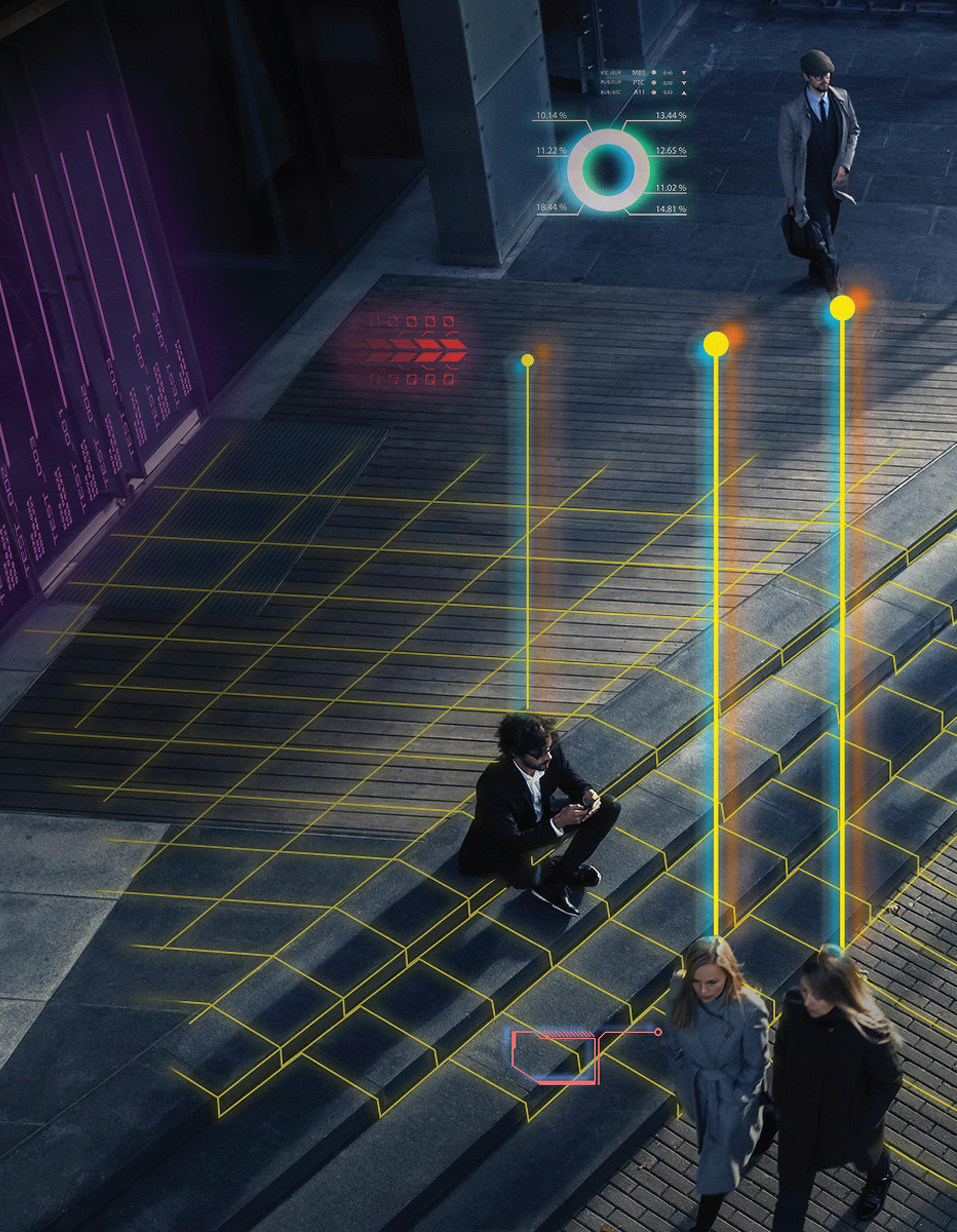
How can AI generate the confidence to reach its potential?












CEO Mark Fried mark.fried@wispubs.com
EXECUTIVE EDITOR & PUBLISHER Stephen Wellman stephen.wellman@wispubs.com
EDITOR-IN-CHIEF Giacomo Lee giacomo@erp.today
DESIGN DIRECTOR Ceci Perriard ceci@erp.today
MANAGING DIRECTOR Tony Little tony@erp.today
SENIOR SALES DIRECTOR Richard McEvoy rich@erp.today
DEPUTY EDITOR Stephanie Ball stephanie@erp.today
TECHNOLOGY EDITOR Adrian Bridgwater adrian@erp.today
COMMERCIAL EDITOR Charles Whitmore charles@erp.today
CHIEF STAFF WRITER Yoana Cholteeva yoana@erp.today
EDITORIAL ASSISTANT Melissa Evatt melissa@erp.today
NEWS ANALYSTS
Ekaterina Dudakova ekaterina@erp.today
Shána H. Briddock shana@erp.today
HEAD OF MARKETING Andrew Rolland andrew@erp.today
SENIOR ACCOUNT
EXECUTIVE Katy Pieris katy@erp.today
Unless you have been living under a rock you will have been exposed to the tremendous coverage and hype around AI and machine learning. You know when Oprah Winfrey is dedicating an hour-long show to discuss this trend that it has hit not just business and IT circles, but the mainstream media and consumer population too. But how much of this is hype versus reality?
I have spent many hours on the phone with CIOs, tech teams, partners, and more on the topic. In a recent CIO study we found that 43% of executives in our study hadn’t even started any AI projects yet. Only 8% of leaders had completed more than five AI-related projects. As such, most companies are still at incredibly early stages of AI experimentation and adoption.
However, IT and business leaders are aggressively investing in learning, education, and experience. Every CIO I have spent time with over the past few months is scrambling to establish an AI knowledgebase, skillsets, and project experience. Getting any experience now is essential to gaining and keeping a competitive advantage. Our research also showed that the top challenge of implementing AI was the lack of business case and skillsets.
Also, it all starts with the data. Executive after executive that I have interviewed are spending a significant amount of time focused on their company data and making sure that it is clean, centralized, and accessible. Many companies know that their AI projects will feed off their proprietary data and need to use that data to train their models.
Finally, note your partners have invested in or are investing heavily in AI solutions. From SAP to major consultancies such as Accenture to software and hardware partners, all are aggressively investing in AI and touting their built-in AI capabilities and features. Understand how you can unlock these capabilities and any technical prerequisites that you will need to meet them.
There are various takeaways here. First, you need to aggressively gain experience with AI. It’s important to gain practical experience with AI and ML so that you can build internal resources and knowledge. Partnering can help accelerate learning, but you need to preserve your internal knowledge base so that you can maintain your competitive advantage.
20-22
ERP.TODAY
PHOTOGRAPHY Kurt Rebry Jay Watson erp_today
Secondly, know your partner’s AI strategy. Leverage solutions and technology you already have. Spend some time with your partners to explore use cases that can impact your business the most and talk to other customers who are further along the path so that you can learn from their experiences.
Thirdly, evaluate your data. To unlock data’s full potential in training and development, you must be able to centralize and validate this data on an ongoing basis. Explore cloudbased data lake technologies to select the right solution and path for you.
Lastly, build an AI center of excellence. You need a centralized organization that is only focused on AI which helps set standards and governance models, explore partner solutions, and systemize learning and knowledge sharing across the company. It is important that this organization carries with it both IT and business skills and personnel to ensure that it reflects the needs of both entities.
- Rizal Ahmed, CIO Leader & Research President, Wellesley Information Services




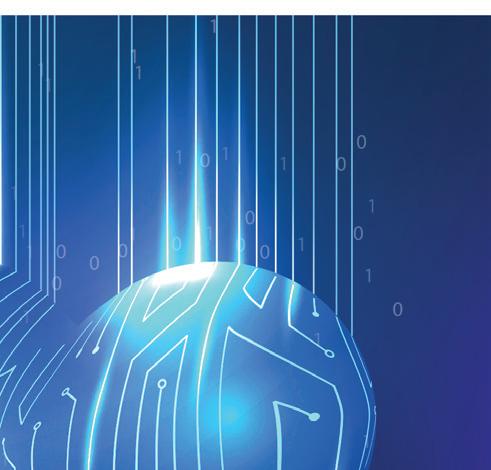
“Doing things that organizations could never do
Mark Vigoroso on the next AI EAM use cases

A marriage made in innovation, IBM’s Mike Perera talks 50 years strong
Epicor’s Vaibhav Vohra in an exclusive with Giacomo Lee
TUI
Carrefour Belgium’s CTO on the future of retail with AI
Getting
Oracle
Automated
Robert








































Growth comes with its fair share of wibbles and wobbles, and adopting a new ERP system might feel like one of the biggest. But it doesn’t have to be.
At NTT DATA Business Solutions, we help businesses navigate the complexities of ERP adoption with SAP S/4HANA Cloud Public Edition. With our proven methodology, you can say goodbye to disruptions, hidden costs, and complicated processes. SAP S/4HANA Cloud Public Edition provides real-time insights, enhanced productivity, and seamless scalability, empowering you to grow at your own pace.














BY WELLESLEY NEWS ANALYSTS
SAP has acquired WalkMe, a leader in digital adoption platforms (DAPs), to enhance the customer experience.
The envisioned partnership will help end users on their transformation journeys by complementing SAP’s Business Transformation Management portfolio around SAP Signavio and SAP LeanIX solutions with WalkMe’s guidance and automation solutions.
As part of the acquisition, SAP and WalkMe are planning to integrate the upcoming WalkMeX copilot, which will use WalkMe’s contextual
awareness and AI to suggest the best next step for any workflow, with SAP’s copilot Joule projecting to boost AI assistants and productivity gains for all SAP customers.
WalkMeX has the capability to always be on, serving as an overlay to any application, including copilots from different vendors that companies use in their landscapes.
Additionally, SAP shared that integrating distinctive elearning features in the SAP Enable Now solution with WalkMe will form the center of SAP’s people-centric transformation approach.
The companies added that
despite the acquisition, WalkMe will continue to support non-SAP applications.
“Applications, processes, data and people are the four key elements of a successful business transformation,” said Christian Klein, CEO and member of the Executive Board of SAP SE.
“By acquiring WalkMe, we are doubling down on the support we provide our endusers, helping them to quickly adopt new solutions and features to get the maximum value out of their IT investments.”
Dan Adika, CEO of WalkMe,
also commented on the announcement: “We are thrilled to join forces with SAP. This acquisition marks a significant milestone in our journey, providing us with the resources and customer base necessary to enhance our product offerings and expand our market reach.
“By leveraging SAP’s extensive ecosystem, we are poised to unlock substantial growth opportunities and deliver even greater value to our customers. Together, we look forward to a future filled with innovation and exceptional service.”
The acquisition was subject to customary closing conditions, including the receipt of WalkMe shareholder approval and necessary
regulatory clearances, and was expected to close in the third quarter of 2024. The impact of the transaction on SAP’s non-IFRS earnings per share for fiscal 2024 is expected to be immaterial.
Sister site Mastering SAP reported WalkMe user stories from APAC customers including Origin Energy and Blackwoods.
Origin used WalkMe to improve employee use of its SuccessFactors solution, reducing help desk tickets by over 70% and reducing 2-day processes to 20-second self-service actions.
“Now, employees are uploading their licenses and safety certificates themselves, so we can refocus people’s efforts on higher impact tasks,” said Frank Malley, Head of Process & Employee Experience for Origin. “The ActionBot jumps between softwares and walks you through the seven or eight different screens and makes it look seamless.”
Blackwoods, a subsidiary of Wesfarmers, implemented Walk Me as a part of the change management strategy for its Microsoft Dynamics company wide technology initiative. This increased time-to-proficiency for new team members by 50% and slashed generation process by 15%.
“With traditional job aids, you need to search for the right page. WalkMe just knows what ‘page’ you’re on,” said Darryl Crumblin, Blackwoods Sales Training and Enablement Manager. “Implementing process
automation with WalkMe significantly streamlines everything from our order and sales processing to our inventory management, resulting in improved employee efficiency and a better customer experience.”
The WalkMe announcement was made at this year’s SAP Sapphire conference in Orlando, where SAP continued its Business AI push with a raft of new generative AI product offerings and AIfocused partnerships with other software vendors.
Announced at this year’s SAP Sapphire conference, the company’s Joule AI copilot will be added to more of its product portfolio, including SAP Ariba and SAP Analytics Cloud.
results, helping customers unleash the agility and ingenuity they need to succeed in today’s fast-moving business landscape.”
SAP CONTINUED ITS BUSINESS AI PUSH WITH A RAFT OF NEW GENERATIVE AI PRODUCT OFFERINGS
SAP will also look to bolster Joule’s capabilities with plans to integrate it with Microsoft Copilot for Microsoft 365, allowing users to use both solutions simultaneously and seamlessly.
SAP has also announced extended partnerships with Google Cloud, Meta, Mistral AI and Nvidia centered around Business AI.
“The Business AI innovations we’re announcing at SAP Sapphire in 2024 will redefine the way businesses run,” SAP CEO Christian Klein said.
“Today’s AI announcements and partnerships build on our commitment to deliver revolutionary technology that drives real-world
Business AI to drive value Examples of the value of Business AI include AIgenerated reports in SAP SuccessFactors solutions that give people managers responsibly sourced insights for compensation-related discussions as well as forecasting capabilities in SAP Sales Cloud solutions that predict combinations of salespeople and products most likely to drive sales. Meanwhile, the SAP Business Technology Platform is adding large language models from Amazon Web Services, Meta and Mistral AI to its generative AI hub. This capability in the SAP AI Core infrastructure makes it easier to build generative AI use cases for SAP applications.
SAP’s generative AI copilot Joule was announced in September 2023 and is now available as part of SAP SuccessFactors solutions, SAP S/4HANA Cloud solutions and others including SAP Build and SAP Integration Suite. Further expansion by year-end will include SAP Ariba and SAP Analytics Cloud solutions. At Sapphire, SAP also announced plans to further broaden Joule’s scope via a bi-directional integration with Microsoft Copilot to surface insights from business applications in SAP and Microsoft 365.
Reflecting Business AI’s increasing importance, SAP is adopting the 10 guiding principles of the UNESCO Recommendation on the Ethics of Artificial Intelligence, which aim to ensure that AI technologies are developed and used in ways that respect human rights, promote fairness and contribute to sustainable development.
As part of the AI push, SAP is partnering with best-in-class technology leaders to deliver AI to aid supply chain planning, analytics and to create a technology hub to advance generative AI in enterprise and business settings including AI in RISE to SAP implementations, ABAP coding and digital twins. SAP and Google Cloud are expanding their partnership, using Business AI to help enterprises better predict and mitigate supply-chain risks to minimize disruptions and maintain optimal inventory levels. The companies will integrate Joule and the SAP Integrated Business Planning for Supply Chain solution with Google Cloud’s Gemini models AI assistant and Google Cloud Cortex Framework’s data foundation.
SAP will leverage Meta Llama 3 to generate scripts that render highly customized analytics applications in SAP Analytics Cloud. Meta’s next-generation AI model excels at language nuances and contextual understanding, making it an ideal candidate for translating enterprise business requirements into tangible outcomes.







BY SHÁNA H. BRIDDOCK
Data-driven decision-making allows companies to personalize their offerings and predict market trends with greater accuracy; without access to this data, cloud and ERP companies risk falling behind competitors. Industryspecific cloud software solutions company, Infor, has announced the acquisition of a data-migration partner, Albanero, and a CPG consulting expert, Acumen, to keep its data capabilities up to par.
Infor’s acquisition of Albanero brings significant advantages in moving customers to the cloud and optimizing their data solutions. The integration of Albanero’s data mesh platform with Infor OS aims to provide a consolidated enterprise view of data - a key differentiator in the market. Albanero’s decentralized approach to data management also addresses challenges as-
sociated with centralized data systems, empowering data owners at the source and providing a robust data foundation for leveraging advanced technologies like GenAI.
INFOR HAS CONTINUED ITS STRATEGY OF ACQUIRING COMPANIES THAT ENHANCE ITS DATA CAPABILITIES
“Cloud technologies have enabled Albanero to innovate in how data is managed,” explained Manish Sharma, founder and CTO of Albanero. “We are excited to provide Infor customers with a decentralized data mesh
solution that puts the power of their data back into their business.
“This technological leap has addressed many of the challenges associated with centralized data management by empowering data owners at the source.”
In acquiring Acumen, a specialized consulting and analytics company that leverages data analytics for consumer packaged goods (CPG) manufacturers, Infor aims to enhance its offerings in the industry. Acumen’s expertise in optimizing promotional investments and pricing strategies is vital for managing complex pricing requirements and responding effectively to market changes. By integrating Acumen into Infor CloudSuite Food & Beverage and CloudSuite Fashion, Infor adds critical functionality for Trade Promotion Management.
This integration establishes a single source of truth for decision-making, enhancing the industry-specific data available for developing new technologies and capabilities.
Nick Ryan, co-founder of Acumen, said: “Joining Infor will enable us to leverage the latest Infor technologies to enhance our platforms and speed to market while enabling us to continue to grow our client base and extend our geographic reach.”
Over the past year, Infor has continued its strategy of acquiring companies that enhance its data capabilities through other strategic partnerships and innovations across its industryspecific CloudSuites. For instance, its partnership with SourceDay aimed to optimize direct material purchase order management by integrating deep, bi-directional technology across Infor’s Discrete Manufacturing and Distribution ERPs, emphasizing proactive data accuracy.
Additionally, aligned with
last year’s bi-annual release cycle for customer agility, Infor included enhancements in ESG reporting and Infor GenAI, especially aimed at leveraging industry-specific data for improved decision-making.
Infor’s competitors are also making similar moves to enhance their data capabilities and cloud offerings. SAP’s acquisition of Signavio was directly aimed at enhancing its process management and data analytics capabilities, enabling better data-driven decision-making. Additionally, SAP has been focusing on its Data Intelligence solution to help organizations manage complex data landscapes.
been expanding Azure Synapse Analytics, a comprehensive data analytics service that integrates big data and data warehousing.
By enhancing its data migration, management and analytics capabilities, Infor is right on track with its biggest competitors, with the goal of taking advantage of a robust data foundation for its cloud solutions.
INFOR’S COMPETITORS ARE ALSO MAKING SIMILAR MOVES TO ENHANCE THEIR DATA CAPABILITIES AND CLOUD OFFERINGS
Microsoft’s acquisition of Nuance similarly sought to improve its AI and data capabilities in the healthcare industry, enhancing the ability to analyze clinical data. Microsoft has also
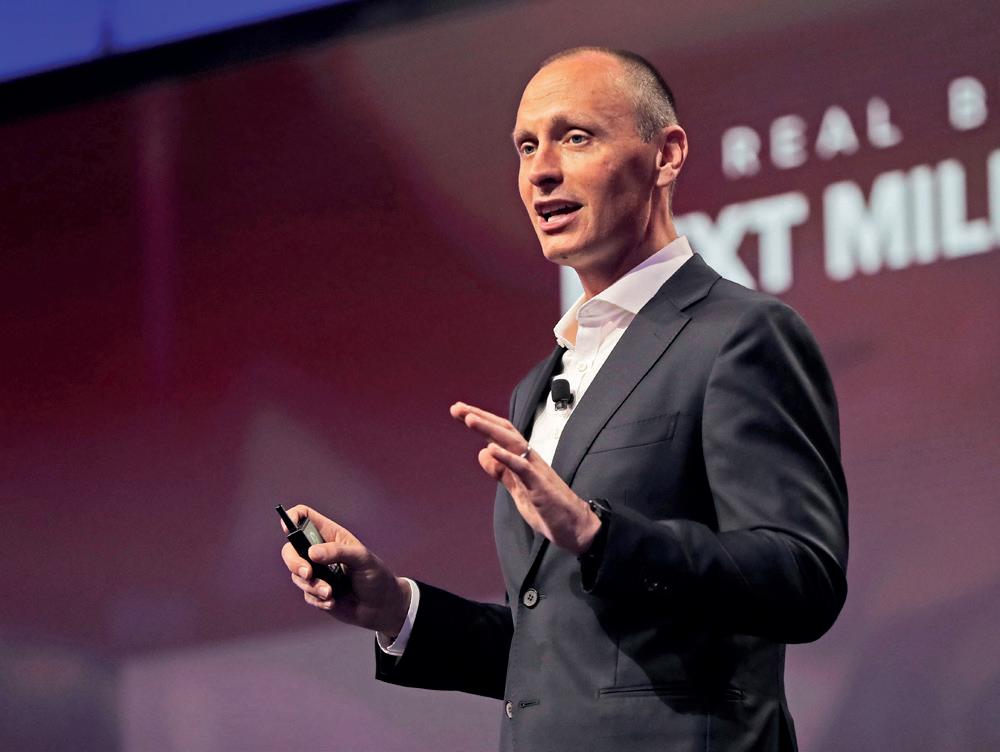
“Infor’s strategy remains fiercely focused on helping customers unlock core value drivers within their industry-specific operations,” said Infor CEO Kevin Samuelson. “The next wave of innovation is completely data-driven and generating real value from it begins with a secure industry-rich data foundation.”
A close insight on what AI means for Infor customers can be seen in the case study of leading European manufacturer of savory snacks Intersnack Group. With Infor CloudSuite Food & Beverage at its core, Intersnack embarked on a journey to harmonize its global processes, from procurement to supply chain management.
The deployment of Infor solutions not only facilitated compliance management but also empowered Intersnack to drive growth and expansion in a rapidly evolving market – just as GenAI began to take center
stage. With a digital transformation team at H&L Digital and AI capabilities via Infor Coleman, Infor took deployment to the next stage, providing Intersnack with a framework to drive automation and then AI.
At a recent Infor Velocity World Tour event, Christoph Laufen, head of CoE at Intersnack Group was passionate about the importance of data integration as it pertains to upcoming innovations like AI: “Utilizing data from various systems into one is instrumental in unlocking valuable insights.”
With one seamless data system, Laufen suggested that: “GenAI can help us learn how to set the machine to the best possible parameters.”
At the same event, James Davies, director of global business systems at iconic British motorcycle manufacturer Triumph Motorcycles, said the company is set to embark on the next phase of its ERP journey, leveraging Infor’s cutting-edge technologies to streamline manufacturing processes, enhance customer experiences and drive global growth.
With a clear focus on data-driven decision-making, Triumph Motorcycles aims to cement its position as a trailblazer in the motorcycle industry and Davies thinks AI is going to get them there. He said: “AI is here to stay, [it’s] the next industrial revolution, without a doubt. It’s an opportunity to refresh your business model.”
































Join us for an exceptional learning and educational experience and connect and collaborate with professionals who are steering their companies’ ERP strategies and technologies. We will deliver the key strategies, roadmaps, case studies, and actionable takeaways critical to accelerating your AI in ERP strategy.
Key topics include:
• AI concepts, trends, and terms
• Building the Business Case for AI
• Tools and Technologies to Enable AI in ERP Environment
• Evaluating your ERP and IT Landscape for AI Readiness
• Building an Enterprise Integration Strategy to Support AI
12 December 2024, London
Park Plaza London Riverbank
TICKETS ON SALE NOW!






Each submission represented innovation, creativity, and dedication and set the standard for future projects and shaping the landscape of enterprise resource planning. The winners will be announced at our awards celebration dinner on December 12, 2024 at Park Plaza London Riverbank, bringing together global industry leaders and the emerging innovators and disruptors.

https://reg.eventmobi.com/erptodayawards



BEST ERP VENDOR
Enterpryze Epicor
Forterro Infor QAD

CUSTOMER
EXPERIENCE SOLUTION OF THE YEAR AWARD
IFS
Infor
Kaizens Group
ERP AI AND INNOVATION OF THE YEAR AWARD

Rootstock Software SAP Workday


FINANCE SOLUTION OF THE YEAR AWARD
EY
Innovate Tax
Inoapps
insightsoftware Kyriba
LTIMindtree
Rossum SplashBI
NTT DATA Business Solutions Opkey SugarCRM Vertilocity Wipro Limited
Automation Anywhere Axiamatic Inc. Celonis Deloitte LLP
Embridge Consulting Epicor IFS Infor KPS AG NTT Data Business Solutions
SAP UK Limited Wipro Ltd

HR TECH SOLUTION OF THE YEAR AWARD
IBM UK Limited iCIMS
Inoapps Strada Workday Zalaris
ESG EXCELLENCE OF THE YEAR AWARD

Data Migration International
eKal Solutions Ltd
IBM UK Limited IFS SAP UK Limited SUSE
OPERATIONAL INNOVATION OF THE YEAR AWARD
Axiamatic Inc. IBM Infor
Original Software Turnkey Unifii
TRANSFORMATION PROJECT OF THE YEAR AWARD

Accelalpha Agilyx Group Boomi
Boss Consulting
Codestone Group Ltd
Deloitte G3G
Kaizens Group SAP UK Limited
Snowflake Syniti Wipro Ltd


BY SHÁNA H. BRIDDOCK
At SAP Sapphire Barcelona the theme was clear: “bring out your best.” But here’s the catch – if you aren’t moving to the cloud your access to AI will be limited, and without AI you can’t be your best.
But isn’t cloud an old story? Throughout 2024, it has become evident that AI requires the processing capabilities of a cloud environment, and those who questioned the necessity of the cloud can’t deny that AI is the future.
With so many companies accelerating their cloud plans, the real question becomes - now what? How can businesses ‘bring out the best’ in their cloud
transformations and in their newfound innovations?
But first, during this European-flavored version of Sapphire after the Orlando event the previous week, AI certainly took center stage with several announcements of new innovations and collaborations between SAP and leading EMEA/UK brands to drive automated innovation. Let’s dive in.
SAP’s taps
The name of the game is business AI.
At SAP Sapphire Barcelona, one of the big reveals was SAP’s GenAI copilot, Joule, teaming up with Microsoft’s Copilot for Microsoft 365. This combination aims to make life easier for users by seamlessly integrating SAP and Microsoft
365 apps. A dream come true for the Teams fan.
Scheduled to kick off later this year, this integration will blend SAP’s enterprise data with Microsoft 365’s contextual knowledge from Teams, Outlook and Word, to allow for richer insights and enhanced decision-making capabilities.
What does this mean for users? Christian Klein, CEO, SAP, explained: “This two-way integration is the only one so deep that no matter which co-pilot you’re going to use, it’s one experience.”
SAP and head of SAP Product Engineering said of this team-up: “Unlocking the massive potential AI has to offer requires capabilities that are high value, reliable and available in-context in the applications that people use today.”
“HOW DO WE MAXIMIZE THE VALUE FOR AS MANY CUSTOMERS AS WE CAN?”
On day two of the event, Muhammad Alam, member of the Executive Board of
Continuing on its mission to simplify workflows, SAP then discussed its intention to acquire WalkMe, a top-tier provider of digital adoption platforms (DAPs). WalkMe’s solutions are designed to streamline operations by offering sophisticated guidance and automation, ensuring smooth execution of workflows across various
applications. This not only boosts adoption rates but also enhances the overall value derived from IT investments.
The acquisition, valued at around $1.5 billion, is anticipated to finalize in the third quarter of 2024, pending regulatory approvals and approval from WalkMe shareholders.
“Applications, processes, data and people are the four key elements of a successful business transformation,” said Klein. “By acquiring WalkMe, we are doubling down on the support we provide our end users, helping them to quickly adopt new solutions and features to get the maximum value out of their IT investments.”
ONE OF THE BIG REVEALS WAS SAP’S GENAI COPILOT, JOULE, TEAMING UP WITH MICROSOFT’S COPILOT FOR MICROSOFT 365
Sapphire event, Klein made sure to explain why this decision is of particular interest to European-based companies: “Mistral AI will be available via our generative AI app to all our customers globally. Even better, together we will also ensure that business AI will also be available in an endto-end sovereign cloud in Europe. This is because we know it is of high importance for many customers, especially in regulated industries, that their mission critical data will reside and be managed in Europe. Welcome Mistral AI to the SAP family.”
Philipp Herzig, chief AI officer (a newly added role known as the CAIO) of SAP, said: “We are excited about entering a partnership with Mistral AI and making the company’s LLM accessible to both our developers and our customers through the generative AI hub in SAP AI Core on SAP BTP.”
“Together, we can truly make a difference by building AI-enabled solutions that create immediate value for users, organizations, and entire industries. We are particularly proud that two European technology companies are collaborating on bringing AI forward.”
fairness and contribute to sustainable development.
From the GenAI and Microsoft Copilot collaboration, the acquisition of WalkMe for enhanced digital adoption and partnerships with Mistral AI and NVIDIA to bolster AI capabilities within SAP’s platform, the event attempted to hone in on the one thing that everyone is asking after their cloud journey has come to a head.
In another step forward on the AI train, SAP has entered into a partnership with Mistral AI, a pioneer in LLMs. This collaboration will integrate Mistral AI’s advanced models with SAP’s suite of AI-enabled solutions, providing direct access through SAP BTP.
By integrating Mistral AI’s advanced models directly into SAP BTP, users gain unprecedented access to state-of-the-art AI functionalities. This means enhanced productivity, streamlined operations and the ability to leverage sophisticated AI-driven insights right within SAP applications.
As this was the EMEA
Whether through integrating AI with SAP BTP or developing bespoke solutions through direct access to Mistral AI LLMs, the potential for innovation seems limitless.
Reflecting the growing importance of ethical AI that many users had questions about, SAP has adopted the 10 guiding principles of the UNESCO Recommendation on the Ethics of Artificial Intelligence, committing to the development and use of AI technologies that respect human rights, promote
SAP Sapphire Barcelona comes at a critical moment in enterprise technology, whether you’re an organization still on SAP ECC and contemplating the jump, deep in your cloud journey already or trying to figure out how to capitalize on your newly minted AI innovations - the moment is not a matter of if these innovations will change the business world, it’s a matter of how fast – and will you be able to keep up?


BY YOANA CHOLTEEVA
At Snowflake Summit 2024, Snowflake unveiled a flurry of developments to boost how much organizations and data analysts can get out of its offerings, including unlocking the power of AI across teams.
In his keynote, Snowflake’s Benoit Dageville, co-founder and president of product, emphasized that “after all, enterprise AI is only as good as the data foundation it is built on” while listing the top most important elements of the
data journey - like “elastic on-demand compute for both CPUs and GPUs, enabling you to easily build and run any workload; access to world-class models, in a serverless version optimized for efficiency and governance at every layer; and the ability to share and access AI models and apps, not only within your organization, but also cross-cloud, cross-region and even cross board”.
Snowflake proceeded to announce a new collaboration with NVIDIA to help customers and partners build customized AI data applications in Snowflake,
powered by NVIDIA AI.
In this string of partnerships, Snowflake has adopted NVIDIA AI Enterprise software to integrate NeMo Retriever microservices into Snowflake Cortex AI, its fully managed large

Sridhar Ramaswamy
language model and vector search service.
This is poised to enable organizations to connect custom models to diverse business data and deliver highly accurate responses.
In addition, Snowflake Arctic, the open-grade LLM, is now fully supported with NVIDIA TensorRT-LLMsoftware, to provide users with highly optimized performance. Arctic is also now available as an NVIDIA NIM inference microservice, allowing more developers to access Arctic’s efficient intelligence.
As enterprises look for ways to apply their data strategically and drive customization, through Snowflake’s collaboration with NVIDIA, users would be able to more rapidly create bespoke, use-casespecific AI solutions and realize the potential of enterprise AI.
“Pairing NVIDIA’s full stack accelerated computing and software with Snowflake’s state-of-the-art AI capabilities in Cortex AI is game-changing,” said Sridhar Ramaswamy, Snowflake’s CEO. “Together, we are unlocking a new era of AI where customers from every industry and every skill level can build custom AI applications on their enterprise data with ease, efficiency and trust.”
Snowflake equips developers with building skills in Snowflake Cortex AI
Snowflake also unveiled new tools to accelerate
how developers build enterprise-grade pipelines, models and applications with their data.
In this way, the company is furthering its mission of eliminating complexity for customers with new developer tools and native integrations that speed up development and empower them to ship more advanced products in the AI Data Cloud.
“Thousands of developers around the globe already rely on Snowflake as their go-to development platform. Our latest innovations continue to push the boundaries of what builders can create in the AI Data Cloud, bringing familiar, yet powerful experiences to their enterprise data where it already lives,” said Jeff Hollan, head of applications and developer platform at Snowflake.
SNOWFLAKE IS DEMOCRATIZING HOW USERS CAN CUSTOMIZE AI FOR SPECIFIC INDUSTRY USE CASES THROUGH A NEW NO-CODE INTERACTIVE
For example, Lukas Biewald, co-founder and CEO of Weights & Biases, shared that using Snowflake Notebooks, the company can easily integrate its experiment tracking with Weights & Biases directly within notebooks.
“Centralized, secure access to Snowflake data and compute lets you run data engineering and analysis alongside ML modeling in a notebook-style format that’s familiar, intuitive and powerful. We’re excited to see how our customers use it to run experiments faster,” Biewald said.
The company also revealed innovations and enhancements to Snowflake Cortex AI to unlock the next wave of enterprise AI for customers with efficient and trusted ways to create AI-powered applications.
Increased interoperability with AWS, Salesforce and Microsoft Snowflake also launched its Polaris Catalog, a vendorneutral, open catalog implementation for Apache Iceberg – an open standard of choice for implementing data lakehouses, data lakes and other architectures.
The Polaris Catalog will be open-sourced for the next 90 days to provide enterprises like Goldman Sachs and the Iceberg community with more choice, flexibility and control over their data. The offering also promises full enterprise security and Apache Iceberg interoperability with AWS, Confluent, Dremio, Google Cloud, Microsoft Azure, Salesforce and more.
Software Foundation project in May 2020, Apache Iceberg has since surged in popularity to become a leading open-source data table format. Building up on this, with Polaris Catalog, users can gain a single, centralized place for any engine to find and access an organization’s Iceberg tables with open interoperability.
To help Polaris Catalog meet the evolving needs of the wider community, Snowflake is collaborating with the Iceberg ecosystem to drive the project forward.
SNOWFLAKE LAUNCHED POLARIS CATALOG, A VENDORNEUTRAL, OPEN CATALOG IMPLEMENTATION FOR APACHE ICEBERG
Offering these latest innovations, the company is “ultimately putting AI in the hands of more users,” he added.
It is also arming developers with more ways to accelerate their AI development directly on their data in the AI Data Cloud with Snowflake Notebooks (now in public preview) natively integrated with the full breadth of the Snowflake platform, including Snowpark ML, Streamlit and Snowflake Cortex AI.
The additions include new chat experiences to empower organizations to develop chatbots within minutes so they can talk directly to their enterprise data and get the answers they need faster.
Snowflake is also democratizing how users can customize AI for specific industry use cases through a new no-code interactive interface, access to industry-leading large language models and serverless finetunings.
Christian Kleinerman, EVP of Product, Snowflake, told ERP Today in a media briefing session: “We are bringing together a number of industry partners to make sure that we can give our mutual customers a choice to mix and match multiple query engines and coordinate read and write activity, and most importantly, to do so in an open fashion without having lock in.”
Kleinerman also emphasized that this can “further simplify how organizations access their data across diverse systems with increased flexibility and control”.
Emerging from incubation to a top-level Apache
For example, Chris Grusz, MD of technology partnerships at Amazon Web Services, said that AWS is committed to working with partners on open-source solutions that can accelerate choice for customers: “We’re pleased to work with Snowflake to continue to make Apache Iceberg interoperable across our engines.”
Similarly, Raveendrnathan Loganathan, EVP of software engineering at Salesforce, said that Apache Iceberg’s popularity has contributed to an open storage standard that simplifies zero-copy data access for organizations across their ecosystem.
“We’re thrilled to have Snowflake as a member of our Zero Copy Partner Network and we’re excited to see how this new open catalog standard will further zero-copy access in the enterprise,” he said.

BY WELLESLEY NEWS ANALYSTS
SAP believes it is “the operating system of the global economy in the era of AI” and that business leaders must focus on delivering operational excellence in a world dealing with several disruptions, according to SAP ANZ President and Managing Director Angela Colantuono.
Speaking at this year’s SAP NOW event in Sydney, Colantuono continued the push for customers to move
to the cloud and benefit from cloud-exclusive offerings like Business AI.
“Over the last six months talking to so many CEOs,

there’s a common theme that emerged – it has become quite a tough operating environment for organizations and we’re all feeling the prolonged effect of a volatile economy,” Colantuono said.
“Inflation and interest rate changes are on the mind for many, and we continue to witness the fragility of our supply chains, whether it’s from a changing climate or a geopolitical disruption. Labour shortages also remain a challenge to boost
productivity levels.
“While we can’t control these challenges, leaders must focus on delivering operational excellence, and that means moving to the cloud. It’s all about simplification – an opportunity to simplify our systems, organizational processes and how we get work done.”
Colantuono also touched on SAP’s financial results across the Asia-Pacific and Japan (APJ) region, citing the 38 percent year on year cloud revenue growth.
“We can’t talk about mov-
ing to the cloud without talking about AI, and SAP, we feel is the operating system of the global economy in the era of AI,” she added. “There’s never been a better time to partner with SAP.”
Continuing the cloud push
Colantuono was later joined by SAP APJ Chief Business Officer Liher Urbizu, who discussed how digital transformation programs would fail for exclusively focusing on technology, and that a balanced approach involving people and processes would be the key to success.
onboarding and learning processes, and staff retention.
“As a company that prides itself on helping clients embrace the tools of the future, we saw how relying on better technology would support our growth and deliver a first-class experience to our people,” Atturra Chief Operating Officer David Dekker said.
SAP CONTINUED THE PUSH FOR CUSTOMERS TO MOVE TO THE CLOUD AND BENEFIT FROM OFFERINGS LIKE BUSINESS AI
AWS also took the stage to discuss how to build a future-ready culture within an organization, suggesting organizations reconsider their operational horizons and find ways to free up resources and reduce costs to adapt to the rapid pace of change in this current business environment.
Also speaking at SAP NOW were former top professional tennis player Ash Barty, WTA Ventures SVP of Partnerships Sarah Cummins, and New Zealand Rugby CEO Mark Robinson.
Focus on customers
Australian IT services provider Atturra implemented SAP SuccessFactors, reporting improvements to the accuracy of its HR data,
“Implementing SAP SuccessFactors has streamlined our onboarding process, allowing new team members to settle in and start learning and contributing faster. In the second phase we added further functionalities with the Performance & Goals, Learning and Recruiting modules. This has been a game changer in promoting a culture of continuous development, boosting employee engagement and supporting our goals for sustainable growth and innovation.”
Pharmaceutical goods wholesaler and distributor Sigma Healthcare imple-

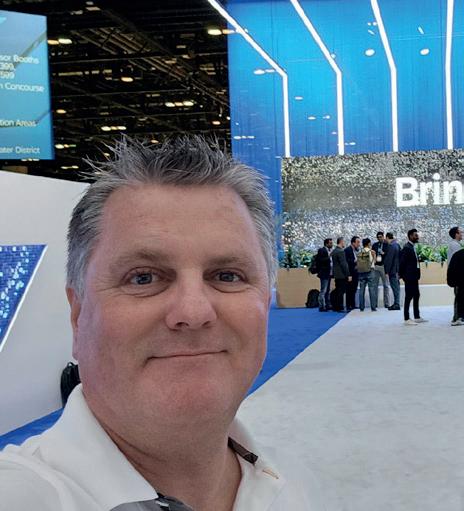
mented SAP Integrated Business Planning for Supply Chain (SAP IBP) to streamline its supply chain operations. The company reported improvements in operational efficiency, inventory management, customer service and customer satisfaction across its network of pharmacies.
“Since implementing the Response and Supply module of SAP IBP, we have seen improved metrics across the board, including reduced inventory, increased availability and greater efficiencies,” Sigma Healthcare CIO Martin Hawkins said.
“This transformation could not have been achieved without the hard work and dedication of both the EY team and our Sigma Operations Planning Team. The new system has also improved our ability to forward plan for events such as supplier closures and public holidays, further enhancing our service to customers.”
Powerlink Queensland, which earlier this year implemented SAP Sustainability Control Tower, has chosen RISE with SAP on Microsoft Azure to implement SAP Business AI.
This deal is the utility’s latest engagement with SAP following Powerlink’s implementation of SAP S/4HANA and SAP Analytics Cloud in 2022, and more recently, SAP Sustainability Control Tower.
Powerlink CEO Paul Simshauser said RISE has helped strengthen the organization’s sustainability reporting through the consolidation of auditable climate-related metrics aligned to Australian and International standards.
“Powerlink has a longstanding relationship with SAP, reaching a 25-year milestone this year, that has

delivered significant value to our organization with recent uplifts in data management, automation and self-service,” Simshauser said.
“We opted to accelerate our move to RISE with SAP as it is a natural progression of our digital transformation and AI advances. With many of our mission critical processes already running on SAP, having the ability to leverage SAP Business AI capabilities will deliver tremendous value to our people.”

BY YOANA CHOLTEEVA
The Automation
Anywhere Imagine conference in Austin, Texas, saw Mihir Shukla, CEO and co-founder of Automation
Anywhere share that this year has marked an unprecedented collaboration with the company’s customers jointly working on hundreds of capabilities and groundbreaking AI innovations - “as 98 percent of you have chosen to be on our latest product releases, 98
percent... That’s an incredible number,” he said.
With the company bringing 50 percent more customers than before to share their stories on the main stage, in breakout sessions, in communities and with partners, all eyes seemed to be on how organizations can leverage the new opportunities to achieve better and faster results.
“If you take a look at a sample of the financial services industry, we have four customers presenting and 40 of the largest banks in the audience. [And with
our] customers, we collectively have 350 million of them. That’s the size of the United States population,” boasted Shukla.
Similarly, looking at healthcare and life sciences, many of the companies presenting their stories consist of 25 of the world’s most trusted healthcare brands.
New announcements Automation Anywhere kicked off the event by unveiling its new AI + Automation Enterprise System, which sees the two elements join up to drive
bigger outcomes for businesses.
The company’s new offering is infused with its second-generation GenAI Process Models to speed up discovery, development and deployment of AI process automation.
Automation Anywhere also launched new AI Agents to manage complex cognitive tasks and automate more across enterprises.
The solutions promise to help organizations achieve efficiency improvements, driving process tasks that formerly took hours down to minutes, deliver 3x time to value and up to 10x business impact across business workflows that include customer service operations, finance, IT and HR. With organizations on a quest to working smarter, not harder, Shukla said that “automation is the foundation that’s gotten us part way there. But AI Agent-powered automation is the breakthrough that will take us beyondto automate the seemingly impossible, create a new operating model for business and drive enterprise transformation with stunning results.”
A new feature includes the ability to build custom AI Agents with the new AI Agent Studio where AI Agents have the ability to learn from enterprise data, make informed decisions and take action responsibly across an enterprise system, speeding processes by up to 90 percent.
The new AI Agent Studio, which is gener-
ally available, provides developers with low-code tools to build, manage and govern custom AI Agents. Developers can start with the foundational model of choice, including models from AWS, Google Cloud and Microsoft Azure OpenAI Service.
Enhanced Autopilot, which is also generally available, enables crossfunctional teams to go from discovery to automation in record time by quickly converting process documentation into draft process automation using generative AI. Autopilot now allows for inputs from mining tools in BPMN format to build automation.
The copilot is now faster for business users to get work done across applications with chat capabilities for on-demand assistance to ask questions of knowledge bases, call on AI Agents or initiate automations.
THE COPILOT IS NOW FASTER FOR BUSINESS USERS TO GET WORK DONE ACROSS APPLICATIONS WITH CHAT CAPABILITIES
“Automation Anywhere continues to seamlessly integrate AI and automation to help customers get more out of their AI investments. These latest enhancements and platform capabilities, including AI Agents, make AIpowered automation even more accessible, empowering organizations and employees to leverage AI in new ways, helping them work smarter than ever before,” said Maureen Fleming, program vice president of intelligent process automation research at IDC.
The Automation Co-Pilot, an embed-anywhere enterprise assistant for organizations is now conversational (in preview status) amid a new integration with Amazon Q Service.
Automation Anywhere also announced in Texas further collaborations with Microsoft and AWS to deliver more automation to organizations with GenAI. The company announced at the Imagine conference that it has expanded its collaboration with Microsoft through the integration of Microsoft Azure OpenAI Service within Automation Anywhere’s new AI + Automation Enterprise System, to help companies automate complex end-to-end processes across enterprise applications using AI Agents.
The announcement expands the existing integration of Automation Anywhere’s enterprise


automation platform with Azure AI Document Intelligence. The new AI Studio solution promises customers to build AI Agents for complex enterprise automation use cases on GenAI models from Azure OpenAI Service.
Steve McNamara, VP of automation engineering at R1 RCM, an American revenue cycle management company servicing hospitals, said: “Leveraging the ability to rapidly create automation solutions that take advantage of LLM-based data mining, and generative AI responses will create distinctive advantages in the healthcare sector.
“R1 RCM is heavily invested in Microsoft Azure and Automation Anywhere. This new partnership will play a significant role in our future automation strategy.”
Continuing on this trend, the executive team revealed its plans to roll out new solutions every month and every quarter, with solutions “to combine multiple products like automation, copilot and enterprise assistant, enabling business teams to engage with AI agents from any business application, Salesforce,
Microsoft, SAP, or even that custom web application that you built in house,” Adi Kuruganti, Automation Anywhere’s CPO, shared at the conference stage.
The company has also partnered with AWS to expedite business transformation and help customers achieve rapid cost savings by automating complex enterprise workflows with generative AI.
Automation Anywhere aims to empower customers to create enterprise-wide process automations within minutes with conversational automation, turning natural language requests into automated actions.
It does this by leveraging Amazon Q, a fully managed, generative AIpowered assistant that can be configured to answer questions, provide summaries, generate content and complete tasks based on enterprise data.
Business users can use Amazon Q to solve problems and gain insights as it provides immediate, relevant information and advice to employees to streamline tasks, accelerate decision-making and help spark creativity.
“By making conversational automation available enterprise-wide with Amazon Q, we’re arming every employee in companies with the potential to automate and transform their challenging process workflows to transform the way they work and reduce the time it takes from days and weeks to minutes,” said CEO Shukla.

BY SHÁNA H. BRIDDOCK
SAP has announced various significant leadership changes in the quarter, with Jürgen Müller, chief technology officer and executive board member, stepping down by the end of September. This follows
last month’s surprising departures of Julia White, chief marketing and solutions Officer, and Scott Russell, chief revenue officer. This sudden exodus of C-suite executives has raised concerns about SAP’s leadership stability and future direction, especially as the company continues its cloud-first and
AI-focused strategy.
Müller’s departure reportedly comes in the wake of an incident at a company event, where he admitted to behavior “inconsistent with SAP’s values”. In his statement, Müller expressed regret, taking responsibility and noting that stepping down is in the best interest
of the company.
Müller stated: “I want to address an incident at a past company event where my behavior was inappropriate. I regret being inconsiderate and sincerely apologize to everyone affected. I recognize my behavior at that moment did not reflect our values at
SAP. I take full responsibility and believe stepping down is best for the company. I wish the team continued success.”
In the interim, SAP CEO Christian Klein will assume responsibility for much of the Technology and Innovation Board area Müller led. This mirrors the situation following White’s and Russell’s departures, where Klein also took on many of White’s responsibilities.
Robert Holland, vice president and research director, SAPinsider, suggested: “The biggest impact Müller has had during his tenure as CTO was bringing together multiple offerings with SAP Cloud Platform to create SAP BTP. SAP BTP is essential to SAP’s vision of the future that puts SAP BTP, SAP Cloud ALM, SAP Signavio and SAP LeanIX around the ERP core.”
successful event season in which these leaders showcased SAP’s innovations and cloud-first strategy. White and Müller both played pivotal roles in shaping SAP’s approach to the cloud and AI, yet the company has decided not to seek immediate replacements. Instead, marketing responsibilities are being embedded back into product development, marking a return to SAP’s traditional operational structure.

He continued: “While SAP may be pushing SAP S/4HANA Cloud and RISE with SAP recently, the upsell that SAP has achieved with RISE with SAP customers has often been with SAP BTP services. Without Müller to help continue this vision SAP risks losing momentum in the medium term. This makes it vital for Müller’s replacement to understand where the organization was going, and SAP will need to move quickly to ensure that happens.”
The timing of these departures is interesting, particularly following a
This shift suggests SAP may be consolidating its operations and streamlining decision-making. However, it also raises questions about the company’s commitment to its cloud and AI innovation, which has been central to its recent strategy. The absence of key leaders could stall progress, especially as competitors continue advancing in these areas.
For end users, the leadership vacuum creates uncertainty. Jamie Bedard, CEO of SAPinsider and Wellesley Information Services, said:
“Our members are looking for clear, definitive insight about what the technology vision going forward will be - and we’re looking for the executive board at SAP to step up [following Müller’s] absence.”
The departure of Julia White and Scott Russell was equally surprising, especially following a period of strong financial performance. White, who joined SAP from Microsoft in 2021, was instrumental in advancing SAP’s cloud-first strategy, while Russell led the company’s Customer Success initiatives. Their sudden exits, agreed upon with SAP’s Supervisory Board, were not accompanied by clear reasons, add-

ing to the uncertainty.
In Q4, SAP plans to dissolve the Marketing and Solutions board area, integrating product marketing with product engineering and having global marketing report directly to the CEO. This organizational restructuring mirrors the structure that existed before White joined the company, suggesting a potential return to SAP’s precloud strategy days. While the company continues to push its “Suite-first and AI-first” agenda, these leadership changes signal a potential shift. SAP’s focus seems to be moving towards public cloud-first solutions, with a growing emphasis on modular offerings and Business AI.
However, the lack of clarity around SAP’s leadership succession could cause hesitancy among users and partners, who may question whether the company can maintain its innovation pace. The next era of SAP’s growth is undoubtedly underway, but whether this signals progress or a step back remains to be seen.

BY MELISSA EVATT, CHARLES WHITMORE
IFS announced its acquisition of advanced provider of AI-powered enterprise Asset Investment Planning and Management (AIPM) company Copperleaf Technologies. IFS say the purchase is to add further depth to the firm’s position as a global enterprise application software provider.
Copperleaf uses financial data to help clients make informed investment decisions and is also an active participant in global indus-
try standards and sustainability principles by being part of the United Nations Global Compact and the Institute of Asset Management.
The Vancouver-based firm’s software is responsible for managing up to two trillion dollars of global physical and digital assets, which includes Northern American energy utility giants like ONE Gas, Manitoba Hydro and National Grid.
CUSTOMERS WILL BE ABLE TO USE INDUSTRIAL AI-POWERED SOFTWARE TO MANAGE CRUCIAL BUSINESS ASSETS
All business asset and
investment data gathered by Copperleaf is stored in a single, collaborative repository - which can be used to create accurate forecasting of asset risks and costs. Copperleaf’s analytics can assess hundreds of thousands of potential investments and rapidly formulate an optimal business plan. Both IFS and Copperleaf considered the joining of their organizations to be complimentary, with the acquisition adding breadth to
IFS’ current software capabilities. When the union of both companies is finalized, customers will be able to use industrial AI-powered software to manage crucial business assets in enhancing the efficiency and effectiveness of their operations. The transaction for the acquisition of Copperleaf is set to be completed in the third quarter of 2024.
On the acquisition of Copperleaf, Mark Moffat, CEO, IFS, commented: “IFS continues to build on its position as the global software leader for Asset and Service management, powered by Industrial AI. I am

deeply excited about what Copperleaf brings to our extended customer offering. We combine two companies built on the same principles: world class innovative technology with unrivaled time to value, asset and industry expertise delivering exceptional ROI, and organizational cultures that have always put the customer at the center of everything they do.”
Paul Sakrzewski, CEO, Copperleaf, added: “I am incredibly proud of the work Copperleaf has done to establish and create the business we have today. Our market-leading solution is now utilized by many of the largest and best run asset owners in the world. Our next phase of growth as part of IFS will enable us to accelerate even faster and offer customers even greater capabilities, thanks to shared values and a commitment to delivering the most advanced and commercially impactful software assetowners could need.”
Amidst the recent news, Copperleaf has also announced a collaboration with European transmission system operator, Ten-

neT, to help connect all assets and areas as a means of portfolio optimization.
IFS and PwC UK to streamline CSRD journeys for customers IFS and PwC UK have announced an ESG collaboration to bring to market a Sustainability Management Solution that will include vital technology and services supporting compliance with sustainability disclosure requirements.
The initiative will see IFS develop a Sustainability Management module within IFS Cloud. PwC will contribute with its expertise in ESG criteria and the evolving landscape to assist in the design and build.
Once completed, IFS customers can navigate the new requirements of the Corporate Sustainability

Reporting Directive (CSRD) and other emerging regulatory standards. To ensure a seamless journey, customers leveraging IFS Cloud can enlist the services of PwC to guide them on various issues they may face in relation to governance, along with mandatory strategic ESG tasks.
The module will feature CSRD metrics, select IFS Cloud data mapping, approval workflows, target setting and insights. The module will also deliver a library of KPIs, including quantitative metrics supported by PwC’s ESG experts. The tool aims to support customers as they navigate the sustainability disclosure landscape
while helping them focus on delivering business value through opportunities to transition to more sustainable operations.
Moffat, IFS CEO, said: “The strategic coalition between IFS and PwC is not just a technological advantage; it is a commitment to shaping a sustainable and transparent ecosystem. By equipping customers with the necessary tools and data, we are together enabling decisive sustainability action and ensuring we maintain the highest standards in sustainability disclosures.”

Carl Sizer, PwC UK management board member and ESG sponsor, said: “We’re thrilled to collaborate with IFS in developing the Sustainability Management module within IFS Cloud. Our expertise in ESG criteria and knowledge of the regulatory landscape will enable us to provide valuable guidance and support in designing a solution that empowers organizations to effectively manage their sustainability initiatives and navigate the evolving regulatory landscape.”
The first version of the Sustainability Management Module is set to launch in the IFS Cloud 24R2 release in November 2024. Alongside this, PwC UK will provide the required services for companies to be compliant with the first CSRD reporting cycle in 2025.

BY WELLESLEY NEWS ANALYSTS
While Business AI and the WalkMe acquisition took center stage at this year’s SAP Sapphire conference in Orlando, SAP also unveiled new offerings for Cloud ERP and SAP Business Technology Platform (SAP BTP).
RISE with SAP customers will now have a dedicated enterprise architect – including both new and existing customers – aimed
to guide them through the RISE with SAP Methodology across the whole lifecycle.
SAP CEO Christian Klein called this addition the “next evolution of RISE”.
“Consider this enterprise architect your new best friend in business,” he said.
Some examples Klein gave on how the enterprise architect will help include teaming up on process simplification in the early stages and ensuring that SAP BTP is being used as the standard integration platform during the migration process.
RISE now also comes with an integrated set of tools, including aligned SAP and non-SAP application architecture via LeanIX; business process management through SAP Signavio and Cloud Application Lifecycle Manager (ALM) to oversee the entire lifecycle of applications.
RISE with SAP Methodology. This aims to assist customers find partners with the expertise and experience in large, complex or multi-country RISE with SAP implementations.
GROW with SAP premium customers will now have access to SAP Sales Cloud and Concur Expense for no extra cost starting July 2024.
SAP Sales Cloud automates parts of the sales process and provides insights from collecting customer information and transactions. Concur Expense provides real time visibility of cash flow and automates invoice, expense and travel processes.
Business AI in supply chain and procurement Ahead of Mastering SAP Connect later this year, SAP has also infused Business AI and the Joule copilot into its supply chain and procurement product offerings.
SAP Transportation Management will use AI to expedite freight verification and documentation by automatically extracting, posting and checking critical information from delivery notes.
SAP also introduced RISE with SAP Validated Partner Designation, which verifies an SAP partner’s adherence to
SAP AI copilot Joule will be integrated with SAP Integrated Business Planning for Supply Chain to provide customers with detailed analyses of planning runs. Joule will identify
root causes of order delays and provide suggestions for corrective measures.
SAP Quality Issue Resolution will also leverage AI to address recurring issues faster by bundling similar quality incidents and identifying any remedies.
Another area getting an AI boost is SAP Asset Performance Management, where visual inspectors can more easily annotate, display and compile images collected from inspections to help with maintenance decision-making.
SAP Ariba Category Management will turn to AI to help reduce onboarding time for new category managers and accelerate category strategy and planning development.
AI will enable hiring managers using SAP Fieldglass to generate and maintain job descriptions faster to streamline recruitment of external workers, while project managers can deliver detailed statements of work faster.
For buyers, the buying 360 capability in SAP S/4HANA Cloud Public Edition now allows customers to bundle products and services into a single transaction via generative AI.
Joule will also be integrated into SAP Ariba Sourcing to give sourcing managers product and supplier recommendations to create requests for proposals. These recommendations will consider cost-effectiveness, carbon footprint impact, local compliance regulations and past transactions.
New clean core, master data enhancements on SAP BTP
SAP BTP has added new generative AI features to its SAP Build low-code and pro-code tools and in ABAP Cloud aimed to maintain a clean core strategy.
SAP’s Business AI copilot Joule now allows developers to write ABAP code using generative AI to create ABAP business objects within SAP BTP. This feature is available in beta and is planned for general availability in the second half of 2024, with more capabilities set to launch early 2025.
SAP Build Code will also use Joule to enable customers to build Fiori front ends to their SAP S/4HANA Cloud systems.
SAP Build Work Zone also includes guided experiences for developers to create step-by-step lineof-business workflows, automating business processes without custom code.
all software applications. This data hierarchy will also be replicated across business and analytical applications like SAP Analytics Cloud and SAP Ariba Supplier Lifecycle and Performance.
A new Microsoft partnership sees SAP Analytics Cloud content now able to natively integrate with Microsoft PowerPoint through a new add-in set to launch later in 2024, enabling users to connect to an SAP Analytics Cloud tenant and find user-created content.
Customers can also connect SQL data sources as live data connections in SAP Analytics Cloud, improving access to real-time data, reducing data storage requirements, providing more reliable data consistency, improving system performance and lowering costs.
SAP QUALITY ISSUE RESOLUTION WILL LEVERAGE AI TO ADDRESS RECURRING ISSUES FASTER
SAP Build will also be accessed directly from SAP S/4HANA Cloud Public Edition starting from the second half of 2024, aimed to create an integrated SAP Build experience for developers.
SAP Master Data Governance, cloud edition now includes a feature to assist customers in organizing their legal relationships with customers, vendors and partners into a data hierarchy consistent across
SAP Signavio will also get the Business AI treatment, with Process AI, a collection of generative AI capabilities trained on a large language model comprising business process knowledge and more than 5,000 SAP best practices.
This will be launched in two main features – a process recommender feature in H2 2024, and a promptbased process mining feature later in 2024.
The SAP Cloud ERP portfo-
lio also features a new set of sustainability tracking, monitoring and reporting capabilities.
SAP Sustainability Control Tower now allows customers to automatically report on their available environmental, social, and governance (ESG) data.
SAP Sustainability Footprint Management bolstered its carbon footprint calculation capabilities with automated emission factor mapping recommendations.
Both solutions also feature a new carbon calculator engine that allows customers to align their emissions reporting with universally accepted carbon accounting practices by making data collection requirements in one data set.
SAP Green Ledger will also have accounting of greenhouse gas emissions available “later” in 2024.
SAP also extended its partnership with Everstream Analytics to integrate dedicated supply chain risk scores and information into SAP Integrated Business Planning for Supply Chain, aiming to identify risks and plan for a risk-aware supply chain for customers.
This aims to provide customers with real-time insights about events, risks and opportunities across their end-to-end supply chain processes, as well as anticipate any impact of disruptions while optimizing planning strategies to keep organizations running.

BY GIACOMO LEE, STEPHANIE BALL
Oracle CloudWorld 2024 took over Las Vegas in September, pitching up in The Venetian Convention and Expo Center to showcase the latest updates regarding Oracle’s software and its ecosystem. The flagship event for Oracle is also worth watching for more “purple shaded” news when it comes to the Oracle-IBM partnership, and the latest
in the relationship between Big Red and Big Blue.
The big news is, as one might expect, AI based, but with an added twist. While AI is a prominent theme, less prominent perhaps has been the implementation and upskilling when it comes to AI on the end user level. The average cost of compute spend is expected to increase by 89 percent between
2023 and 2025, according to new research from IBM’s Institute for Business Value. In addition, IBM shares, 42 percent of executives report concern that inadequate expertise could preclude progress with generative AI, or GenAI.
In response, IBM Consulting is launching an expanded network of consultants to support Oracle clients, as certified across core Oracle tech-
nologies – such as OCI Generative AI, OCI AI Services, and OCI Data Science – as well as being skilled in the IBM watsonx AI and data platform.
The plan will see consultants help clients extend high value GenAI use cases coupled with traditional AI and automation solutions, aimed, IBM says, to maximize their return-oninvestment and optimize compute and implementation costs. This includes helping clients choose and deploy the right fit-
for-purpose AI models for their unique requirements, including enterprise-grade models such as IBM Granite, open source or other third-party models.
Utilizing skills in IBM watsonx and technologies from IBM’s open ecosystem of business partners, IBM sees its consultants as a crucial link in guiding clients’ critical decisions around technology architecture, GenAI and software licensing, data and analytics architecture, security risks and more to enhance automation of their workflows. The promise is to also help establish a stronger and more cost-efficient technology foundation for developing and deploying generative AI applications, a fitting move considering the current question marks around ROI on AI investment.
ness, organizations must balance the value generative AI can create against the investment it demands and the risks it introduces.
“To help tackle that, consultancies are leveraging the power of generative AI to help clients in their Oracle ERP transformation journeys. For example, by embedding generative AI into IBM’s Oracle transformation programs, it is possible to unlock value early, improve user experience and enhance productivity.
ACCELALPHA ACQUISITION TO ACCELERATE CAPABILITIES IN SUPPLY CHAIN, LOGISTICS, FINANCE, EPM
“Generative AI continues to be the topic of conversation in the news and the boardroom. Research from the IBM Institute for Business Value reports that 64 percent of CEOs say they face significant pressure from investors, creditors and lenders to accelerate adoption of generative AI” Anindya Chaudhuri, senior partner at IBM Consulting UKI, recently wrote in thought leadership for ERP Today. “With pressures from external stakeholders to innovate and various economic and geopolitical pressures impacting busi-
“Generative AI has the potential to transform the way organizations approach ERP transformation. By combining the power of AI with the capabilities of Oracle ERP systems, clients can achieve greater efficiency, productivity and value from their technology investments,” Chaudhuri concluded.
Accelalpha
September also saw IBM announce its intent to acquire Accelalpha, the

global Oracle Cloud Applications consultancy, bulking out its supply chain management capabilities.
Having nurtured an almost 40-year partnership with Oracle, IBM said it hopes the acquisition will accelerate its capabilities in the supply chain, logistics, finance, EPM and CXCPQ skills, helping clients’ Oracle cloud application adoption.
Cloud Applications.
“Many enterprises depend on Oracle to run the workflows that are at the heart of their enterprise,” said Kelly Chambliss, senior vice president, IBM Consulting, Americas.
“With our acquisition of Accelalpha, IBM will be even better positioned to help our clients deploy and manage Oracle solutions, including generative AI and cloud technology, for competitive advantage.”
Accelalpha’s consultants bring expertise across the Oracle Cloud Applications Suite including Oracle Supply Chain Management (SCM) and Logistics, Oracle Cloud Enterprise Resource Planning (ERP), Oracle Cloud Enterprise Performance Management (EPM), Oracle Cloud Customer Transformation (CX), and Oracle Configure, Price, Quote (CPQ).
Nat Ganesh, CEO, Accelalpha commented: “IBM’s client and employee-centric culture and long-established scale and reach in more than 175 countries is a great fit for the next stage of our growth.

Headquartered in Bellevue, Washington, Accelalpha’s expertise focuses on the distribution, industrial and financial sectors across Oracle advisory, implementation and managed services. As an Oracle Cloud Excellence Certified Implementer, Accelalpha boasts the largest Oracle logistics practice globally and was the first Oracle partner to implement Oracle Fusion Financials.

Upon close of the deal, set to take place in the fourth quarter 2024, the Accelalpha team of consultants across North America, Europe, Asia, the Middle East and South America, are set to onboard at IBM, helping clients further modernize with Oracle
“We’re thrilled to bring our expertise in Oracle Cloud solutions and targeted domain and industry knowledge to bear together with IBM’s strength in generative AI and hybrid cloud. With Accelalpha’s history of being a pioneer in Oracle Cloud and IBM’s deep-rooted dedication to innovation that matters, we can further accelerate value creation for our clients.”








AN EXCLUSIVE INTERVIEW WITH MARK MOFFAT ON HIS FIRST NINE MONTHS AS CEO OF IFS
BY GIACOMO LEE | PHOTOS BY KURT REBRY
and ERP Today is interviewing Mark Moffat as he reaches his nine-month anniversary as chief executive officer of IFS. When we last profiled an IFS CEO for a cover story feature, the headline was “The Moment of Service”. The cover line, meanwhile, was “Rockstar Service”. It won’t take a genius to work out the messaging, and, indeed, IFS in recent years has become as synonymous with its cloud vendor transition as it is for its service management message to the market.
The Moment of Service tagline - co-opted, not coined by ERP Today, we hasten to point out - also became interchangeable with the tenure of previous CEO and aforementioned cover star Darren Roos, who today operates as IFS chairman. As Roos stepped down from the top role, up stepped Mark Moffat, previously chief customer officer for the vendor, in a move that made sense to all industry insiders. Moffat had struck watchers like myself as a confident and popular leader over the last few years, regularly sharing the room in analyst and journalist meetings with Darren. The transition between the pair was a smooth and respectful one, meaning as I meet Moffat in the heart of Knightsbridge, the real detail to unpick is the transition of IFS itself so far in 2024.
Like any new CEO, Moffat will want to make his mark, especially in this so-called age of AI that is defining the decade. Likewise, there needs to be clear continuity under his tenure, especially from the customer perspective. This means the Moment of Service arguably should remain the mantra, no matter what technological changes are happening in the market.
Moffat agrees, noting that on the artificial intelligence front, he sees the Moment of Service as including an “obligation and responsibility to make sure we play a part in enabling our customers’ AI journey.”
Tellingly, the CEO sees the “IFS Moment” as ensuring one puts themselves in the customer’s shoes. Thus, as a continuation of sorts from his previous role as CCO, Moffat took on the
challenge this year to meet 100 customers in 100 days - this time as chief exec.
The final tally ended up being more than double, and Moffat tells ERP Today the exercise honed his C-suite narrative on IFS becoming more of a “listening organization”.
“The value of listening sharpened through the exercise. It allowed me to remind everyone what we are about as an organization: we’re high touch, and customer-obsessed in our nature.”

Moffat takes pride in some of the customer stories he shares, such as “a highly acquisitive” food manufacturing enterprise who see IFS as “being a part of their value creation story for their investors [due to] our highly composable architecture and Cloud offering in our single data model.”
The customer story as Mark sees it is one full of transformation, ranging across back office operations and how clients develop offerings to their own customers. Unsurprisingly, the exec wants that story to stay the same as IFS grows under his watch:
“What I talk a lot about internally is we can never lose a sense of who we are. And it doesn’t matter whether we’re six, seven, eight, nine, ten billion in revenue - we are fiercely determined to protect our cultural DNA.”
Crucial to this narrative are partnerships. On his 100-day customer journey as new CEO, Moffat says he was reminded of the criticality of the 500-plus-strong IFS partner ecosystem, which he describes as “highly engaged” and “desperate to innovate around our platform”
“I know we’re different and you know why?” he continues.
WE ARE FIERCELY DETERMINED TO PROTECT OUR CULTURAL

“Because I spent 24 years implementing all of our competitors’ technology [...] So I’m actually a bit unique in that respect; no other CEO in my peer group can tell you they’ve implemented the range of vendor competitive technology that I have [over] hundreds of implementations. So I speak with confidence knowing why I think we’re different in certain attributes.
“And on the partner ecosystem, the way we work with our partners is also different - we get them access to all of our tools. If we develop things for ourselves, we make it as available as quickly as we can to our partners [...] They’re treated as part of our community.”
One partner in the ecosystem is PwC, Moffat’s “home” prior to IFS. His last role at the consultancy was as CTO for UK & EMEA, built upon a background with PwC’s energy customers, setting him up rather nicely for the asset-heavy clientele of IFS.
While Moffat mentions a “huge affection” for PwC, he doesn’t necessarily want them viewed differently to others in the IFS orbit. This “all are equal” approach follows a similar line taken by Darren Roos, even on higher profile partners such as Arcwide, the joint venture of BearingPoint and IFS
which formed in 2022 (Arcwide was contacted for comment by ERP Today, which wasn’t yet received by the time of writing).
That said, Moffat does go as far as to note that like other global consulting firms, PwC offers multinational clients a more direct capability - fitting for the UK-headquartered vendor’s increasingly global mindset.
The reach of a Big Four player saw a twenty-something Moffat exposed to some of the biggest companies in the world, the kind of experience, he says, “even today I think is unrivaled.”
While most CEOs have a typical background - and most CEO interviews follow a typical pattern - Moffat shares some rather atypical information about his history prior to his consultancy days.
I learn that Mark grew up in a rural Scottish town with “more sheep than people”. His working-class background meant he worked for “every luxury in life” from 13 onwards, taking his first job in a hotel kitchen. By 17 he was a fullytrained chef, entirely self-funded, and running said hotel as manager by the time he turned 20.
He remembers the chaos of the kitchen well, saying it set him in good stead for life: “You don’t get more intense than

that!” he recalls. “And I think working in that intensity and making prioritization, trade-off decisions in the kitchen environment, the broader hotel environment or customer service are so important.”
After these formative years in hospitality, Moffat was attracted to further education, specifically chartered accountant training, paying out of his own pocket once more. Thus was set his path to the doors of ol’ PricewaterhouseCoopers.
“I had to graft and find a way through to being accepted into PwC. I was told by a number of people that my grades weren’t good enough. That the school I went to wasn’t good enough. The university wasn’t ‘high caliber’ enough to get training at PwC or a Big Four firm. And my attitude honestly was, ‘screw you’. I just did it through hard work, determination and application of effort and became a chartered accountant in PwC.”
Listening to Mark, the link between hospitality manager, chartered accountant and technology CEO makes perfect sense. “At the end of the day,” as he explains, “finance and numbers, that’s a big part of what makes the world go around. Technology is another part. So you put a career in finance and technology together, [and] you can do anything.”
IFS and Industrial AI
Moffat’s career choice was a shrewd move, and today he holds his first-ever CEO role. What can top that? But as we talk, I realize Mark loves a challenge and rising in the face of adversity; he’s a keen runner, for example, often taking part in famously arduous Ironman Triathlons.
Halfway through our conversation, I’m therefore tempted to ask the exec if he now misses the chance to say ‘Screw you’ to the doubters. After all, there’s nothing to achieve now he’s sitting in the big chair, right? Not a chance, as Mark quickly points out IFS’s journey to ERP superiority is not yet over.
“We’re a $1.5bn dollar revenue company or thereabouts. And that needs to be five, six, seven, eight billion. The size of the market is that big. Our opportunity is even bigger, and we’re just getting started.”
That’s serious fighting talk, and it comes from a place of confidence in the next step for IFS dominion: as of 2024, the vendor is betting big on AI, with Mark the company’s figurehead in this age of GenAI. Where Darren Roos brought IFS into the cloud age for the “Moment of Service”, the very determined Moffat seems poised to build on the cloud for its next-stage eventuality of enterprise AI. Another sign then, if needed, that ERP, EAM and AI are coming together, with IFS’s customer base of asset-heavy industries not immune from the technology theme.
The name of the game, to be precise, is Industrial AI, with the service management “moment” augmented by an AIbased scheduling and optimization engine.
“It’s market-leading because customers tell us it’s market leading, and we’re winning significant numbers of market share,” says Moffat proudly, before highlighting that GenAI is just one aspect of the IFS Industrial AI offering. Just as relevant - if not more so - to his customer base, he says, are capabilities in anomaly detection and forecasting, with optimization opportunities available for plant and capital-intensive sites.
The CEO is also keen to note that, as is widely known, the return on AI investment remains a giant question mark. For his customers, Moffat is keen to stress that IFS is “relentlessly focused” on ensuring any AI-centric capability in their products is based on what customers want and which will drive real return.

“We will have 100 unique AI capabilities in our software in the 2025 R1 release; ‘24 R2 will have 50 [...] and we’re making sure that of the 50, then the 100, that they’re not just use cases but they’re being adopted at scale by our customer base.”
With its single data model, he believes, the IFS Cloud solution is in a good position to capture all the heavy data from asset-heavy orgs: from pressure gauges, temperature and other sensors, collected across wind turbines and more. Said data can be aggregated with use cases applied to it, accentuating a “super compelling” ability to create long-term innovation cycles in AI.
This can extend into the field service management (FSM) offering, with Moffat giving the example of a van technician being able to put together equipment as recommended by an AI-based forecast, before setting off on a dynamically scheduled route to meet their customer.
“So there’s a high probability that they turn up with the right equipment, on time, with the ability to get that customer going with whatever the problem is, all in record time.”
Recent acquisitions have furthered the FSM and AI portfolio under Mark’s watch; he mentions this summer’s purchase of aviation maintenance software player EmpowerMX, say-
PUT A CAREER
TOGETHER, YOU CAN DO ANYTHING
ing it has extended the IFS AI capability to improve uptime, reduce maintenance times and increase ROI.
While Moffat sees all these recent acquisitions as extending the company’s AI reach, he interestingly gives a new slant on the most recent incorporation, that of decision analytics firm Copperleaf Technologies. The day of our interview marked
the completion of the CAN$1bn deal, with the exec laying out the purchase as an integral part of the IFS ESG roadmap, as led by one of the various new names appointed to his C-suite this year, chief sustainability officer Sophie Graham. Another name is Bianca Nobilo, chief external affairs officer as appointed by Moffat and Roos to lead relations between bodies such as those of government and industry.
Nobilo tells ERP Today there is government interest in ways to spur energy-efficient productivity to increase output alongside delivering on sustainability goals and aligning with new regulations. She notes that asset-heavy industries are actively seeking ways to reduce their carbon footprint and invest in energy efficiency, with IFS garnering interest in this regard.
“I think the potential applications for Copperleaf’s capital allocation planning for local and national governments and public services are potent,” Nobilo adds when discussing Copperleaf Technologies. “Optimizing the allocation of significant capital to serve myriad priorities, over different time scales, is exactly what Copperleaf specializes in.”
Underlining the decision analytic capabilities of Copperleaf, Moffat draws a through line on how they can help customers think through trade-off choices on capital deployment and investment cycles.
“So they can deploy capital into carbon-intensive or less carbon-intensive in relation to their goals. So Copperleaf is really going to help that ESG agenda.”
With IFS’s prominent footstep in the asset-heavy and carbon-heavy sector, it seems the Copperleaf Technologies addition is one of three dimensions: a further step in the aggressive global plans from the vendor, an extra string to its AI strategy, and an extra leaf to IFS’s green-fingered ambitions which may have been lost in all the AI talk.
“We’re really proud of our achievements in sustainability [and] guiding product roadmaps with our research and development organizations, so we’re extending that reach into the customer domain,” as Moffat elaborates.
“I think that’s a super exciting place for us to be so that we disproportionately influence what’s happening in the market.”
One IFS customer, leading packaging provider Cheer Pack North America, confirms with ERP Today on some of the above. Alex Ivkovic, chief information officer for the company, says they are letting IFS lead the way on AI with confidence, having been a client for almost two decades. Having upgraded to the latest version of IFS Cloud, Cheer Pack is currently looking at its ESG reporting element.
“We sell an inherently environmentally-friendly product and really want to use the manufacturing data to bolster our case,” Ivkovic says. “We are planning to learn more at this year’s IFS Unleashed conference and then create a plan to move this forward.”
So, onto the future then: IFS Unleashed, for one, is coming up in October, with Orlando, USA once again hosting the vendor’s flagship conference. After that are those promised AI

A LARGE NUMBER OF BIG VENDORS TODAY HAVE LOST TOUCH WITH WHO THEY ARE

elements to IFS Cloud’s 2025 iterations - and the next steps in Mark Moffat’s masterplan.
I learn the company will continue focusing on the same industries, and acquisitions will remain complementary and valuable to customers in however they extend the IFS prospect. “We don’t just chase growth - we chase highly additive, accretive, customer-focused capabilities and solutions,” in Mark’s own words.
Expect also for IFS to keep what Moffat terms a nimble, start-up kind of mentality that doesn’t forsake existing clients.
“You’re as good as the last project you delivered. And you trade off a track record of delivery and building trust and integrity in the relationships you develop with customers. And if you build the trust and you build a relationship and you
build a track record, guess what? Customers want to buy from you again because you’ve got a reputation for delivering.
“A large number of big enterprise application vendors today have lost touch with who they are, and lost touch with customer sentiment,” Moffat concludes without naming names.
“So there’s a number of things that I’ve been doing personally, to make sure that we don’t do that and I lead by example.”
In other words, Mark Moffat is the chief executive officer of a rare sort: one who’s made his mark with customers and is intent on making his mark as CEO without forgetting what made his name originally. As a result, IFS is in a good place to help its customers make their own mark in an AI-focused, increasingly ESG-centered world - and any adversities are highly unlikely to leave any kind of mark on its machine.


YOANA CHOLTEEVA
AUTOMATING OPERATIONS CAN LEAD COMPANIES TO MORE INNOVATIONS IN ADDITION TO CONDUCTING SAFER OPERATIONS. BY
From smaller businesses to big conglomerates, priorities are being aligned to increase capacity and become “more sustainable and safer for people,” Vale’s Alexandre Pigatti, head of AI and data democratization, says when it comes to the company’s direction.
Vale is one of the world’s largest mining companies, present in approximately 30 countries around the world with the multinational corporation specializing in the mining and production of commodities such as nickel, coal, copper and iron ore, among others.
While we keep hearing about AI’s imperfections and considerations, there is another story that businesses are sharing about enterprise-grade AI. Take RPA vendor Automation Anywhere (AA), which is focusing its energy on companies that seek help with transforming the customer experience for issues like speed of pre-approval procedures, processing of healthcare claims and specialist doctor referrals. For many industries, Automation Anywhere CEO, Mihir Shukla, tells ERP Today, it is not just about “what you can do better, faster, cheaper, it is [also about] doing things that you could never do before.”
Automating previously manual operations can lead companies to more innovations in addition to conducting safer operations and continuing with processes when conditions are not safe for workers.
For instance, focusing on autonomous work in its Brucutu mine, in eastern Brazil, Vale has built a fleet of autonomous trucks able to go to load and offload locations without any humans behind the wheel.
In unfavorable weather conditions, especially the common case of fog, people cannot operate the trucks due to safety reasons. The problem is that pausing operations due to challenging conditions leads to delays, lost productivity and disruption.
Vale uses AI solutions to predict when fog will appear, with Pigatti explaining that “instead of sending humans to the operation to do maintenance work, we send autonomous trucks. And everything that makes our operations safer, we are very much interested in.”
With the same goal of working safely and more sustainably, as well as in a more standardized way, Vale started its collaboration with Automation Anywhere in 2018, with the establishment of its Centre of Excellence (CoE) in robotic process automation, with a global presence in Brazil, Canada, China and Switzerland.
A particular challenge that the company recently came across as a blocker of growth is that as part of Vale’s strategic direction, the multi-year planning of ore purchase was foreseeing a twofold increase in purchase volume in the coming years, marking a significant test for the current team.
For this reason, the iron ore purchasing area responsible for composing
batches for sale began collaborating with Vale’s CoE to facilitate cost reductions and increased operational efficiency through RPA, along with greater flexibility, traceability and transparency.
One significant benefit that came out of this collaboration was the automation of the process of updating ore purchase prices for each contract signed between Vale and its suppliers, according to market variations, which enabled the business to move faster and future volumes to increase.
When it comes to smoothing out the scheduling differences amid operating in international markets like Oman, for example, with a typical working week being Sunday through Thursday, the AA collaboration played a key role.
Before Automation Anywhere, the Vale team needed a human to be there and take the price of iron ore every day, input it in the SAP system and then another person to validate what the first person did. Amid a lack of shift overlap on Sundays, sometimes the team would wait on transactions until the second person arrived on Monday to validate the price, resulting in significant delays.
“With Automation Anywhere, we did it and we trust the ‘robot’ because it doesn’t commit mistakes, it doesn’t get tired and we could run including Sun -

days - which are useful days in Oman,” Pigatti says.
By leveraging AA’s Autopilot, the company was also able to rapidly identify and submit automation opportunities directly from Process Discovery to the CoE Manager with the required details to speed up the review and approval process.
Automation with Gen AI also played a crucial role as it helped maximize ROI by prioritizing opportunities and delivering the highest business impact, easily assigning developers and automating the creation process.
In a similar case of the possibilities of AI and RPA, PNC Bank shared during AA’s conference in Austin, Texas, that in the case of bank loan applications, banks are often fighting against competitors to win massive businesses like Tesla’s where the stakes are extremely high. While
the usual pre-approval time for just one loan is between six and eight hours, with multiple often accumulating, the bank has successfully incorporated AA’s solutions along the automation workflow to solve it and deal with the complex unstructured documents.
In another critical and understaffed industry as healthcare, the combination of AI and automation is helping practitioners and patients get better outcomes, “especially in America, where so much money is put in healthcare, but outcomes are not the best,” Adi Kuruganti, CPO of Automation Anywhere, tells ERP Today at a sit down interview.
With an elaborate insurance side as part of the healthcare system, which sometimes leaves patients out of pocket, AA is focusing on the very long processes surrounding claims management which often see a lot of back and forth between providers and sometimes manual, outdated systems.
“That’s where a lot of heavy documentation and unstructured documents are. So again, using a combination of document automation and automation/ GenAI, those are the two big areas we focus on within healthcare.”
And while existing challenges can be seen evolving, the solutions available are also not stagnant and moving fast, like the processing of an unstructured contract with AI/ ML models which used to take about nine months to build. Now, the timelines are a lot shorter, usually involving a two or three-week proof of concept (POC) which ends up reaching an 85 percent accuracy as a standard, Kuruganti says.
“The barriers to solutions are now getting lower for certain uses, specifically around documents. And then with AI agents, we’re expanding it so now you can build your own. You still need the same guardrails and humans in the loop but now you can use the power of AI to solve some of the problems you already have. It’s not like every business always has new problems, the problems already exist,” he explains.
With Vale currently having about 3000 active tasks in production environments, resulting in approximately 121,623 hours saved annually, the race to productivity is far from over for businesses… And automation + AI might just be part of what gets us there.
The true impact of AI in EAM is yet to be seen - but potential

BY MARK VIGOROSO
Much has been written about the potential impact of AI across all aspects of the enterprise, including Enterprise Asset Management (EAM). EAM includes the management, support, and maintenance of a company’s physical assets throughout their lifecycle. This lifecycle encompasses capital planning, procurement, installation, performance, maintenance, repair, regulatory compliance, risk management, and asset decommissioning and disposal. According to recent research from our team, only 7% of respondents have “completed” AI/ML deployments in EAM, while many are planning deployments in the next two years.
Although the true impact of AI in EAM is yet to be seen, the present time offers an opportunity to explore and experiment with potential use cases. Predictive AI and generative AI are the two types of AI most relevant to asset management. While predictive AI uses historical data to predict future events or behaviors, generative AI creates new content such as text, audio, video, code, or images.

use cases offer an opportunity to explore and experiment
A predictive AI example use case could involve a visual asset inspection, where a mobile camera captures asset images that are automatically analyzed for defects or anomalies and triggers an alert or workflow in case of a defect.
On the other hand, generative AI use cases could include a conversational front-end to maintenance documentation like manuals, operating procedures, and installation guides; or a maintenance virtual assistant or chatbot that guides maintenance personnel through work tasks. One could also explore developing pre-defined templates to report asset issues based on the equipment type.
A global food manufacturer has been experimenting with AI for about two years. The company operates in both CPG and agriculture, since it farms and grows its own raw materials, and also sells finished products to wholesalers.
One of the first AI use cases at this manufacturer was with the company’s tractor fleet. They gathered all the data that’s readily available from those types of vehicle assets like engine use, oil use, tire pressure, and amount of gasoline used, fed it all into a data lake, processed the data, and drove better decisions regarding the utilization of the fleet and the consumption of materials like gas, oil and tires.
“Rather than relying on human decision-making, our approach was to collect the output data from the machinery into a data lake. We then analyzed this data through AI to examine various scenarios, such as altering tractor routes, opting for fields of different lengths, or changing the turning points of the tractors under varying conditions like dry or wet terrain. These factors significantly affect tractor mobility, usage efficiency, and resource consumption,” explained the Director of Cloud Services at the company. “We integrated this data with Power BI to create comprehensive dashboards, which significantly informed our decision-making process.”
Companies typically start with AI in EAM where this food manufacturer started, with predictive AI use cases to drive better decisions around asset throughput, utilization, and performance. This is consistent with the experience of Unvired, a certified SAP partner providing Connected Worker solutions with in-depth experience in mobile asset management/plant maintenance, field service, digital forms, and inventory /warehouse management-related business processes.
One of Unvired’s customers is a US-based manufacturer of industrial ropes that have to be routinely inspected and rated in terms of wear. These inspections were typically performed manually, but with workforce and knowledge attrition, the company consulted Unvired to find a solution that reduced dependence on human knowledge and resources. Unvired’s solution integrated a machine learning model with a mobile device for inspection that could generate insight based on a picture of the rope.
“We had to solve for how you keep this ML model updated regularly,” said Alok Pant, CEO of Unvired. “There’s model drift. New input is coming, so models drift over time. So, the challenge is how do you keep the ML model updated on the server side and then bring it down to the mobile device seamlessly. This is what we call ML ops.”
THEY INTEGRATED DATA WITH POWER BI TO CREATE COMPREHENSIVE DASHBOARDS, WHICH SIGNIFICANTLY INFORMED DECISIONMAKING PROCESS
Data centralization was one of the biggest advancements for the company as a result of the tractor project. Traditionally, most of the asset information from the farms was stored on-site using various computing systems, including desktops, laptops, and custom-built servers. In an initiative to centralize data storage, management, processing, and analysis, the company implemented a Microsoft Azure Data Lake and selected Synapse for data processing tasks. The company has since hired two data scientists who are dedicated to developing and refining the data models.
Results came in the form of decreased time to resolution and cost of service, and improved customer experience. The company is now exploring additional revenue-generating services based on an enhanced rope assessment and experience.
This asset inspection use case is a perfect user case for automation and AI. Unvired encountered a scenario with a different client where field technicians would photograph the asset and forward it to an expert at the headquarters, only to find out frequently that the image’s quality was too poor to determine if repairs or upkeep were needed. To address this, Unvired has explored Google Vertex AI, employing a Google API that assesses the photos for clarity instantaneously. This ensures that only images that meet AI-enabled quality standards are transmitted to the corporate office, optimizing the decision-making process.
In the case of the food manufacturer mentioned above, the newly appointed Chief Technology Officer tasked the Director of Cloud Services to lead all AI initiatives for the company. This individual just recently put together an AI charter, which includes a provision for a committee that will administer an AI ideation pipeline
and determine feasibility, cost and benefit of all potential projects. With a vast array of machinery to consider, a primary concern is prioritizing efforts. Among the more maintenance-intensive equipment are pumps, which require frequent attention due to their many components and the critical nature of their Mean Time Between Failure (MTBF) performance. In the past, pump performance data was recorded manually on clipboards. However, with AI, there is a move to digitize this information, aggregate it in the SAP system, and apply AI techniques to enhance pump performance and predict potential malfunctions and breakdowns.
Another application of AI in asset management at this company is in the area of video analysis. The company has always captured video of personnel operating equipment for safety and security purposes, but has not always been able to dedicate the resources required to review and analyze footage. Now the AI champion is leading an effort to use AI to analyze video in batch mode and identify instances of personal protective equipment (PPE) violations among employees, which present serious health and safety issues in a food manufacturing environment.
To aid companies like this food manufacturer in the journey from predictive AI to generative AI in the asset management space, Unvired has developed three out-of-thebox generative AI applications under the brand name Eureka. The first is a knowledge assistant that enables contextual search of proprietary data sets and document processing. The second is natural language reporting that allows users to issue a command like “show me my maintenance orders for the past four weeks” and it will hit the database and return the results. The third are autonomous agents that leverage a large language model (LLM) to determine three or four tasks to do without any prompting.
ting really precise answers,” said Pant.
For Unvired, Eureka offers out-of-the box accelerators. But that is just the beginning. Looking ahead, the company is building a team to develop custom AI applications that solve specific customer pain points in asset and plant maintenance and performance. The team is also co-innovating with partners to build domain and sub-domain specific competencies that automate workflows that are common to individual industries.
Build a bridge with mobile applications. Oftentimes, digitizing data is the first step to getting ready for AI in asset management operations. One way to begin to record data digitally is to equip frontline workers with mobile applications and digital forms so they can move away from paper-based processes and manage work orders, inspections, work permits, checklists, safety observations, etc. directly on a mobile device integrated with back-office maintenance applications. This digitized data serves as the foundation for predictive and generative AI applications.
UNVIRED HAS EXPLORED GOOGLE VERTEX AI, EMPLOYING A GOOGLE API THAT ASSESSES PHOTOS FOR CLARITY INSTANTANEOUSLY
Formulate a data strategy. Collecting and digitizing data is step one. From there, business and IT leaders need to partner to establish a data strategy that includes how and where to store data, including how to govern and secure data. It also includes acquiring and developing data science expertise in-house. Most companies are well-served with even a small data science competency to serve as points of contact with analytics, automation, and AI partners. Some companies, like the food manufacturing example, are forming AI governance bodies that evaluate and mitigate risk, assess feasibility of proposed projects, and administer innovation pipelines.
Unvired has customers who are pursuing generative AI proofs-of-concept leveraging Eureka’s capabilities. One of these POCs involves the search of maintenance procedures and installation manuals. The scope included taking thirty PDF documents, breaking them into chunks, and putting those chunks into a vector database. Then, an LLM – whether it is Google Vertex AI or OpenAI – acts on the vector database and can return answers to natural language queries about maintenance and installation. “So, you can say, ‘how do I repair a pump, which is from Pratt and Whitney,’ and the exact answer will come. It is searching off your maintenance documents using generative AI and get-
Start a POC. Asset and plant maintenance leaders should start with a predictive AI proof of concept that uses historical data to predict future equipment events or behaviors. Under the governance of an emerging technology lab or an AI governance council, companies should not be afraid to experiment with small-scale AI projects that are tied to real target outcomes like asset efficiency, asset reliability, worker safety and productivity. EAM solutions providers like Unvired are beginning to integrate AI into their offerings and offer inexpensive proof-of-concept deployments. Keep the initial scope small and accumulate learnings that can be applied to subsequent deployments.
Mark Vigoroso, EAM Leader, Wellesley Information Services
BY STEPHANIE BALL

IBM’s global head of SAP, Mike Perera, shares the wins and next steps in an over 50-year-strong partnership, with cloud migration and emerging GenAI and Quantum technologies high on the roster.

As the original ERP software vendor, it’s easy to think of SAP as the founding parent of the industry - bringing the first ever ERP system, R/1, to life and success from Germany back in the 1970’s. But this goliath actually stemmed from another, even older American firm, and by this point, most of us know the story: SAP’s five founding engineers, Hasso Plattner, Klaus Tschira, Claus Wellenreuther, Dietmar Hopp and Hans-Werner Hector, all turned entrepreneur directly from engineer roles at this daddy of tech firms - you guessed it – IBM (Big Blue).
As the original ERP software vendor, it’s easy to think of SAP as the founding parent of the industry - bringing the first ever ERP system, R/1, to life and success from Germany back in the 1970’s. But this goliath actually stemmed from another, even older American firm, and by this point, most of us know the story: SAP’s five founding engineers, Hasso Plattner, Klaus Tschira, Claus Wellenreuther, Dietmar Hopp and Hans-Werner Hector, all turned entrepreneur directly from engineer roles at this daddy of tech firms - you guessed it – IBM (Big Blue).
One of the oldest and largest technology companies, IBM holds a rich history of hardware, software, consulting and services innovation since its humble beginnings over a century ago.
Ever since, the firm has been focused on bringing new frontiers to the technology world as well as to the businesses building wins with its upshots. Its partnership with SAP began around infrastructure, with IBM Power Systems offered as a scale-up platform for SAP for running large SAP workloads. Today, S/4HANA in particular can still be built on top of IBM Power Systems hardware among other x86 server providers such as Dell, HPE and Lenovo. Over time, IBM has also dabbled in more software pursuits, with, for instance, IBM’s data management products, IBM DB2, offered
as a supported database across ECC and R/3 and S/4HANA, and integrating with Datasphere and the rest of the SAP portfolio. Now also, IBM’s FinOps platform app integrates with SAP too.
From assisting in rising to cloud, to developing solutions around exciting emerging technologies like GenAI and Quantum capabilities, IBM has sought to stay in step with, and in some cases ahead of, every need of SAP users.
To hear about the latest thinking, collaboration and technological innovations developing in this over 50-year-long, platinum-level partnership, we check in with Mike Perera, global managing director of SAP at IBM, as he passed his first anniversary in the role this spring.
Having started his career as an ERP consultant 25 years ago, in many ways, Perera sees his latest IBM role as “coming full circle”.
“For me, what drew me to IBM originally was the opportunity to do a lot of different things for one company, I have a fairly healthy attention deficit disorder, so being able to jump into different things both functionally as well as technologywise.”
Now heading IBM’s global consulting service around SAP technologies, across
its 38,000 certified SAP consultants, and to date over 7500 implementations in 80 countries, Perera has already witnessed a few SAP transformations since taking the reins. Now, he’s keen to make the most of the “big opportunity” in the partnership’s future when it comes to helping end users.
“We’re really the only company that is coming at this from a strong technology partnership and services capabilities in order to bring those two [consulting and services] together, all around, inside and surrounding SAP,” he says.
“Where we are now, I would say, is lightyears ahead of where we’ve been […] 50-60 years ago when we started. The reason I’m in this spot is because the opportunity to take what’s already been a great partnership and take it to a whole other level is really that big - from a consulting services perspective, from a technology perspective,” continues Perera. “How we work better together is what motivates me. Every day is taking two historic technology companies that have made markets respectively and asking how we can bring those together to do the same jointly.”
It’s AI for implementation
As a platinum partner for RISE with SAP transformations to the cloud for the last few years, and with Red Hat selected by
SAP as a preferred RISE operating system, Perera sees IBM playing a large role in assisting businesses in this shift as ongoing. He also teases that this migration or any system update is about to become even easier with IBM and SAP’s collaborative and ongoing use of AI technology.
Though the adoption of SAP AI tools hasn’t seen a huge uptake yet across end user cases, the strength coming now, as Perera shares, is through consultants like IBM actively using AI in all SAP customer engagements.
Last year, IBM announced Project Minerva, an open source toolkit that uses AI and machine learning to refactor old software systems and minimize the amount of rewritten code, and therein, reducing the number of breaks and errors that could appear in the migration process.
For Perera, his key learnings from the consultancy front lines, and additionally from a recent AI-themed SAP client gathering, see customers making the transition to cloud a prime use case, and therein assisting in the specific ECC to S/4HANA dilemma.
“Today and obviously going forward, we use GenAI in every single one of our consulting engagements, and certainly it’s early but we’ve already seen anecdotes where it makes us more effective and efficient, and in turn, we can help accelerate the migrations to RISE in our engagements with clients.
“We hosted a little over 40 clients jointly with SAP, and there was a mix of customers. What came out of there for us, which is more reinforcement of what we’ve seen rather than anything earthshattering is; number one - All those companies are at different points. There’s a huge variety of complexity depending on those clients. How many instances are they running, how many lines of business do they have, how many countries are they running in, that seems to have an exponential effect on complexity for sure.”
The event seemed a good representation of the wider SAP user journey to cloud. While some attendees were already on RISE with SAP, or were even RISE customers running on IBM
Cloud, some customers were taking a brownfield approach, lifting and shifting current systems into RISE, acting as quickly as possible, before going back to the business transformation side later. Meanwhile, others were undergoing a business transformation at the same time as they moved to RISE, and then, a fair number of those clients are still running ECC or even S/4HANA on-prem and are sitting in the planning stages of the move.
As companies’ journeys are all looking very different, for Perera, the benefit here applies as AI and machine learning can help to keep the dots connected for each customer on their transition journey.
“I think there’s a huge opportunity out
USING AI IN ALL SAP CUSTOMER

there that we see with clients as we engage on a regular basis to bring together what you can do around transformation, SAP and the move to RISE with the capabilities that GenAI which up until now were semi-independent. When you merge the two, that’s when magic will really happen. Some of it out of the box from SAP, some of it as part of your transformation journey, some of it as part of just how you fundamentally do business differently as you go forward.
For us, from an implementation perspective, we take our 38,000 SAP consultants, we then take our 19,000 Watson X credential consultants and bringing those together, we’re bringing forth what we believe is a differentiated value proposition to our clients.”
In terms of businesses using GenAI on their own front end use cases, Perera admits we are still in very early days, with IBM being one of the SAP partners currently offering solutions in this area, along with the likes of AWS, Microsoft, Google Cloud, Cohere, Hugging Face, and so on.
Perera shares that, as of spring, almost no clients are applying GenAI with SAP for business purposes in a production way and, with a finger to the wind, estimates the low double-digits for those undergoing experimental GenAI today.
As of last year, IBM’s Watson AI assistant has been embedded within SAP Start, using natural language capabilities and predictive insights to boost user productivity. Moreover, IBM assists with the SAP Copilot - Joule, boosting its “interactive capabilities of asking and needing”, as well as with SAP’s GenAI Hub and assisting with the implementation of outof-the-box GenAI capabilities.
For the AI Hub in particular, Perera is keen to quell outrage over SAP’s limit on AI updates to its cloud customers only (with that daunting 30 percent uplift in costs), saying that SAP’s GenAI Hub enables the emerging technology to be more freely applied, in line with IBM’s support for an open ecosystem.
Perera protests the point, saying: “Putting on my SAP hat for a moment - there’s nothing technically that ties GenAI directly to RISE, so you could actually apply that GenAI Hub if you so choose and if you wanted that AI-as-aservice platform so to speak, you could apply that back to ECC or you could apply that back to S/4HANA on-premise, and then carry forward that investment with you as you move to RISE, in a way that you’re not changing the environment. In many ways, it’s no different than if you go pick your GenAI platform with WatsonX and apply it today directly to ECC or S/4HANA as well.”
The holdup when it comes to actually implementing GenAI solutions, Perera states, is the separate onuses placed on businesses’ core implementation items and newer, emerging technologies.
“As it relates to GenAI, […] many cli-
ents, if not most, are really looking at how do they get the transformation done first, and then GenAI comes second,” says Perera. “The other observation is in most of those cases, the team responsible for SAP is that transformation-centric focus team, and then someone else in that company is responsible for GenAI prototyping, applying the resources, bringing the subject matter expertise to the business scenario use case. Maybe that’s on top of SAP, with SAP, or maybe it’s orthogonal to SAP altogether.
“I think my observation based on that is, I think there’s a huge opportunity out there that we see with clients as we engage on a regular basis to bring the two together and bring what you can do around transformation, SAP and the move to RISE with the capabilities that GenAI which up until now were semiindependent,” Perera continues. “When you merge the two, that’s when magic will really happen. Some of it out of the box from SAP, some of it as part of your transformation journey, some of it as part of just how you fundamentally do business differently as you go forward.”
Ever seeking to be at the forefront of emerging technology, it wouldn’t be a discussion with IBM without mentioning quantum. At a quantum summit late last year, SAP and IBM teamed up to present their collaborative work to date: integrating classical and quantum computing in the context of SAP.
“That use case was specifically around truck loading optimization,” Perera explains to ERP Today, and shares that, today, “we’ve got more that we’re working on together.”
For the truck loading optimization, Perera retells of the perhaps thousands of different scenarios where companies’ success depends on reacting quickly to factors like the weather, whether a truck is broken or it’s still in service, temperature controls outside of the environment and inside the truck, last minute orders, getting supplies to a distribution centerall which may or may not have happened according to plan.
“All of those inputs and a lot more are dynamic on a daily, if not on an hourly, basis, and even less,” says Perera. “With classical computing, you’ve got no way,
given the number of variables you’ve got there, to calculate that in a [fast enough] period of time, before that optimization is stale or no longer relevant. With quantum, on the other hand, you will.”
Perera, as is the rest of the IBM clan, is confident in the commercial viability of quantum for 2030.
“For me, it’s not a question of if it’s a question of when, without a shadow of a doubt, I think we have played a very

visible role in the market of not just saying it but doing it and sticking with that roadmap. So far, we’re perfect, knockon-wood, on the deliveries that we’ve laid out over a multi-year period. And we’re the only company that has been able to demonstrate at scale and emphasize what we’ve been able to do so far.”
The SAP consulting head notes that the unique aspect of IBM’s quantum partnership with SAP is currently on the business application side, not just about building an application on top of quantum but integrating quantum with classical computing and applications.
“The value of what we’re doing together right now, in the context of SAP Business applications, is finding what those interactions look like back and forth between the traditional application and the optimization that’s being done in quantum: The API calls back and forth, all the non-functional things
and the IT systems overall, how those handoffs happen - on top of then solving the business problem. As technology continues to mature, we continue to take bigger and bigger business problems that we can apply and be ready to bring them to our joint clients as quickly as possible.”
IBM Consulting: Servicing the best SAP outcomes
Keen as ever to find the low-hanging fruits of these claims for end users, ERP Today presses for the target industries IBM is looking at with SAP for these emerging technologies.
Perera shares: “So right now we’re working pretty tightly together. From an industry and a market perspective, as it relates to quantum specifically, right now, we’re treating this as a little bit more of a black box that SAP would ultimately bring to clients.
“[In general], there is an interesting intersection in clients that we traditionally have strengthened industries for: financial services, government, retail, consumer packaged goods, that you match and merge with SAP and you see a lot of the same industries.
Each technology has a different use case because obviously, not all AI is ready for quantum and quantum is applicable for AI. But, in each of those industries, you’ve got challenges that you cannot meet with classical computing in the case of quantum or you’ve got the opportunity to transform business in a way that you haven’t been able to up until now with GenAI.”
In the case of this long and steady partnership, it looks likely that opportunity will continue to grow and rise with SAP and IBM, with a promise of more innovations for users to come in the near future. What’s becoming ever clearer in the meantime is that, despite the benefits for the taking, emerging technologies will simply not get as much traction as the initial hype intends, with the majority of businesses sensibly opting for a slower route to innovation. There is no doubt, however, that when SAP users’ roadmaps do actually reach the pressing business need for these technologies, it’s partners like IBM that will have built the knowledge and maturity around implementing them.
Where the biggest names in enterprise tech tell you what they really think, Live!

erp.today/live Candid conversation. Compelling content. Live!
BY

ERP
Robotics, ERP and aerospace: the resume of Vaibhav Vohra, CPTO and EVP for Epicor, is a varied one. Vohra joined Epicor in 2021 as its chief product officer and SVP, coming from previous VP product roles for robotics companies in the San Francisco Bay Area. In 2023, he became the company’s CTO in addition to chief product officer, a role in which he has led the vision between Epicor and AI technology for the enterprise market.
Prior to robotics, the executive was a VP for SAP, again heading the product realm as the German company made its SaaS transition during the 2010s. Ideal experience, one might say, for Epicor, a fellow ERP vendor which has been making its own cloud journey under the tenure of CEO Steve Murphy.
When talking about Vohra, Murphy tells me that sometimes geniuses have a “hard time” breaking out from an intellectual mentality to deal with people and understand their customers.

“[But] Vaibhav is the rare genius who in addition to the very high intellect, is able to understand customer needs and [...] when it comes to human beings, their wants and desires and their need to feel connection, satisfaction about what they do.”
Murphy tells me this in Epicor’s Dublin, California base, on a day ERP Today spoke with both the company’s CEO and CTO. Meeting the latter, Murphy’s description makes sense, with the technologist straddling both worlds of technology concepts and customer needs with aplomb.
A good example is when Vaibhav Vohra is asked about the history of Epicor and AI and what’s changed in the years from inception leading up to the current boom in Generative AI, alternatively known as GenAI. Fittingly, Vohra talks as both CTO and CPO, underlining how AI has changed to be about “empowering workers so they can make more valuable decisions” in their day to day - the frontline staff in the manufacturing and distribution industries which Epicor tailors to.
As detailed in our previous interview with Steve Murphy, Epicor formed out of the financial and accounting software vendor Platinum Software Corporation, which was founded in its headquarters-to-date of Austin, Texas. Platinum had started developing manufacturer-specific software packages in 1998, and by 2005 Epicor was offering what it called the industry’s first manufacturing solution based on a completely service-oriented architecture.
2011 saw Epicor merge with Activant, a leader in supply chain connectivity and the automotive market. In 1984, the California-headquartered company had brought its electronic parts catalog from print to digital. Listing over 8.8 million automobile parts from engine to exhaust, Activant’s Automotive Electronic Catalog was one of the first digital inventories out there, if not the world’s first for the US automotive sector.
From print to digital, Epicor likewise transformed from on-prem to cloud, and became, in Vohra’s words, the first ERP vendor to build an iPaaS into its platform. Today, under Vohra’s leadership, Epicor is steering from cloud to AI. Another way of putting this is from “cloud to Cognitive”, in a nod to the company’s vision of “Cognitive ERP”, a symbiosis between AI and ERP that aims to redefine processes and operations in the supply chain for its manufacturing-heavy customer base.
Talking on the history behind current and past iterations of Epicor and AI technology, the executive notes the company has been working on artificial intelligence for around 40 years, to a half century. Tied in with this was the nascent thinking about the cloud, where cabinets of hardware could be removed to leave workers focusing more on the things that matter.
Vohra sees the SaaS transformation in ERP as the first phase, a perfunctory step where on-premises software gave way to cloud. Not enabled were capabilities coming through now to users such as those said to be possible with GenAI.
“So I think we’re now in the ‘Phase Two’ where SaaS really delivers on its promise of empowering people,” says the EVP, noting that the “numerous cabinets and tangles of messy wires” of yore were eventually replaced by ERPs connecting to a just-asdisordered collection of applications and processes.
For Vaibhav, the mission behind Epicor and AI software is “empowering essential workers with superpowers to give them ten times the skills and insights.”
He continues, “What I mean by that is for AI or any advanced technology to be successful, it has to be ten times better than whatever the human does, right? Essentially AI is going to cost more money. The value will not totally be delivered because of this, so you have to invest far more than you ever think.”
The CTO sees three elements of Epicor’s Cognitive ERP journey, starting with “Handshakes” to redefine how humans and machines talk to each other. For example, an agent can not only answer questions, but also check if its answer is as informative to the degree needed. It could also check context, pointing out to a user that a question may not be relevant and that something else should be asked instead.
Prism, Epicor’s GenAI service, also offers a code assistant to create automated business processes more quickly. There are also tools to automate supplier communications to speed purchasing, enabling users to automatically send Request for quotes (RFQs) to their supplier network, and sift quotes to determine the best price and fastest delivery.
Next are the “Gears”, essentially lowcode tools which make automation and insightful analytics possible on the shop floor. These can be found in the Grow AI offering, helping users to generate, analyze, and act on multiple forecasts related to inventory, demand, and sales (an example of the latter are product suggestions based on past order history).

Finally from Epicor, we find the “Sparks”, which Vohra dubs insights to the power of ten. An example is given of one Epicor customer, Visa Cash App RB Formula One Team, based in Faenza, Italy.
“So we have an AI that actually allows [Visa Cash App RB] to send through all their suppliers and come up with the right trade-offs,” says the EVP. “And then gives you the insight to say ‘you should use this supplier.’”
Epicor is used to track in real time approximately 14,000 components, so the team will know when they need to make or buy a part. When the make or buy decision happens, Epicor Prism allows the team to quickly determine the best vendor to deliver the part at the right price, the fastest, and if that beats the time/cost of making it themselves, they buy it from that vendor.
In other words, the catalog from 1984 has come a long way, souped up and raring to go in a postpandemic world. The CTO goes on to explain how Sparks are industry-specific insights powered by AI.
“It could be not just that example of supplier insight, but also a product recommendation for
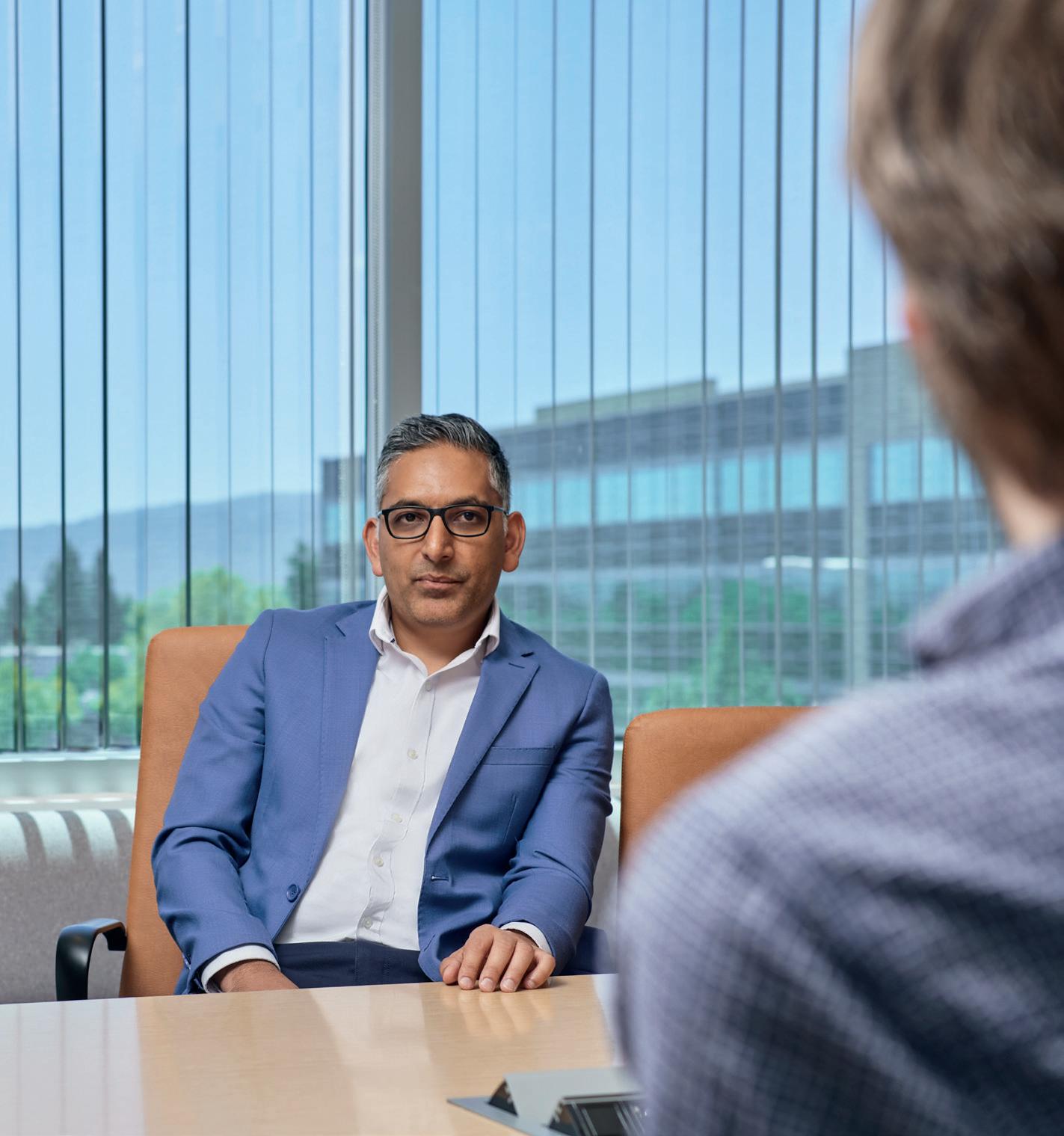
AI IS ONLY AS GOOD AS THE DATA
your customer. Steve mentioned turning a system of records into a system of actions – those are the Sparks,” explains Vohra.
The CTO also elaborates on the Gears element of Epicor’s cognitive ERP, which can help end users learn ERP faster. Citing the forecast that four million jobs are going to be created in US manufacturing by 2030, he notes that 50 percent are estimated to go unfilled due to skills shortages.
“It can take someone a year to two to learn ERP. What if we could bring it down? The Gears are meant to create this easy way to level up through an ERP system,” he says.
It’s an alluring proposition, especially when one considers the rise of AI comes with an increasingly apparent skills shortage, whatever the sector. ERP’s role is a crucial part of this discussion, for as the Epicor leader states: “ERP is the vehicle for AI, right. But AI is only as good as the data.”
Vohra believes Epicor has “the world’s best data” from first-party systems. It’s already on hand through what’s collected in the Epicor ERP, from the shop floor, through to suppliers’ shipping data, commerce data and more.
“These are all things that live in ERP. So by definition ERP companies have the best chance at succeeding at driving significant value with AI. So the more industry specific the better, which is why we feel like we have an unfair advantage.”
ERP Today is reminded that AI models are not one-size-fits-all, as you cannot apply the same model to different sectors. A competitive edge comes from the Make, Move, Sell economy. The data ERP ontology for manufacturing comes from part sub-assembly order, while for distribution it’s quote-to-order, via Epicor’s integrated development environment (IDE).
The technologist sees a level of parallelism between Make, Move, Sell, as reflected within the data model itself. This means when building AI, it’s possible to create a corollary to a use case in manufacturing, to distribution and also to building supply.
“It would be very hard to create that corollary [with other sectors]. It’s just such an orthogonal industry. So I’d say that that’s our competitive edge in the application of our AI.”
Makers, Movers and Sellers blend together as sectors, the EVP continues, instead of making for three distinct verticals. Some companies both make and sell products, for example.
“Everyone has to do some form of payments. Everyone has to make some sort of supply chain decision. Many have a last mile delivery [...] When we’re more focused on it as an aggregate, we can then allow our AI agents to kind of cross over to various products.”
Those AI agents are brought up a lot by Vaibhav Vohra, and in a context that underlines Murphy’s view that the technologist can see beyond the tech and understand the human element driving baseline customer decisions and user operations.
With his background in robotics Vohra notes that where robots were seen as possibly replacing human workers, instead it turned out more skills and technical labor were needed to deal when a robot was introduced into “the wild” of a workspace.
As such, he believes that the idea that putting robots and AI into something means less humans are needed is “absolutely false”.
“When people found that they could use this as a superpower of augmenting what a human could do, that’s when most retailers, manufacturers, and distributors are more successful.”
With robotics, ERP, aerospace and now superhumans in the mix, it seems the skill set of Vaibhav Vohra has leveled up once again, much like the AI evolving behind ERP on an unstoppable trajectory.





















TUI’S GROUP CIO ON ITS HYPERSCALER JOURNEY THROUGH THE PANDEMIC AND BEYOND BY
STEPHANIE BALL

PEOPLE WITH AI WILL OUTPERFORM PEOPLE WITHOUT AI
When borders and airspaces shut up shop, global travel and tourism company, TUI, could have made the same moves as many other businesses – reduce expenses, shut down operations, and hibernate through the long pandemic-winter.
Instead, TUI decided to keep its eyes on the future, shift to the cloud and enable AI implementation, with a mission to redefine personalized travel experiences through a warmer approach. Speaking with Pieter Jordaan, Group CIO at TUI, ERP Today hears of the firm’s journey to TUI’s technology destination.
Having grown from acquisitions, TUI comprises tour operators, travel agencies, online portals, five airlines, over 400 hotels, and 17 cruise liners, and the company was already on a journey to consolidate its technology operations by region.
One of the biggest struggles for TUI had always been the fluctuation and seasonality of bookings, typically selling 70 percent of summer season bookings within a space of six weeks. During peak season, the group’s online operations handle nearly 60 billion searches, 400 million product combinations, and update eight million prices per hour. The rest of the time, data sat in centers often unused, plus for any extraordinary events, such as an airline going bust, TUI would have to struggle to make up those percent volumes and the experience of its 60 million customers per year could be impacted negatively in the course.
With the pandemic, TUI instead gleaned the opportunity to address some of its difficult areas that typically would be very resistant to change.
Jordaan explains: “What really helped was the risk appetite in the business during that time was very high. You went from the business that says, ‘We don’t want to change so don’t touch our systems because it keeps our planes in the air’ to ‘Change now please because my plane is not in the air’. We had a window of opportunity and that shifted the focus to what systems you will move and how fast you will move them.
“To really have the flexibility and scalability, Amazon was the only choice,” Jordaan continues. “What we did was to take probably the biggest problem we had, our complicated stack – that everyone said we’ll never run on Amazon – and say ‘Well, we just have to do it’.”
To get the highest-level of service possible to build greater capability, TUI decided to stop all multi-
cloud stacks and, having been an AWS customer in some regions already, move its stack across over 30 different ecosystems to AWS, net new.
“Instead of what you get with multi-cloud setups, we could immediately start to use serverless, we could use the highest-level AI services. That actually ended up becoming our new migration plan, which was much faster to deliver certain capabilities than if we would lift and shift it.”
With the window of opportunity unknown, TUI pushed a rigorous five-month timeline, despite engineers originally quoting 2.5 years, and achieved the project in six months. This included the significant reengineering that had to happen for the software and the infrastructure to run in the cloud.
Moreover, delivering the IT organization to a globally distributed workforce, TUI began the task of training its IT staff on AWS skills, and now having completed this for 90 percent of its workforce, is currently training them on generative AI.
Most importantly, the technology shift has allowed TUI to scale its operations up and down as needed. Beyond helping to handle the industry’s seasonality, it was ideal timing as, soon after, there was another major event where a competitor moved out of the industry, and TUI immediately saw a 300 percent volume increase in bookings. With AWS in place across the board, TUI could scale within minutes to meet the demand.
Jordaan retells: “At that stage, our CEO came to me and he says, ‘I never understood cloud. Now I do’, and I think that’s probably the hardest part is to get the executives to understand the benefits of it because there are upfront migration costs with it.”
For Jordaan, the cloud-native platform has allowed TUI “to accelerate data consolidation, drive efficiency, and rapidly embrace AI as a dimension on the scene to enrich the customers’ experience, personalizing from inspiration to destination.”
With the cloud foundations in place, last year, TUI was able to launch an AI Lab to drive generative AI adoption throughout the company, and now produces hundreds of use cases all the way from the board level to the people meeting the customer in the resort.
The main goal was to be able to build, test, deploy and measure AI solutions as quickly and successfully as possible, while having and monitoring a secure, cost-controlled, well-governed environment to create new AI solutions, and the tools to train and educate the team.
TUI STOPPED ALL MULTICLOUD STACKS, MOVING THEM OVER 30 DIFFERENT ECOSYSTEMS TO AWS
I SEE A WORLD WHERE PEOPLE WILL DO HARDER AND MORE COMPLICATED TASKS, AND ACTUALLY BUILD BETTER THINGS
TUI chose to implement Amazon SageMaker, the cloud-based machine learning platform for creating, testing and deploying ML models, and since has increased model deployment by 1,000 percent within one year.
Also, in what Jordaan terms an “enterpriseready platform to scale generative AI to all parts of the organization,” TUI has opted for AWS Bedrock as its fully managed, serverless AI service. It has enabled access to a choice of foundational models from companies such as AI21 Labs, Anthropic, Cohere, Meta and so on, as well as a capability set to build generative AI applications.
PEOPLE WILL GO FOR AN EXPERIENCE AND THE TRANSACTIONAL PART WILL JUST BE A BYPRODUCT, NOT THE OTHER WAY AROUND.

Its first uses have been leveraging the models Lamba 2 for generating hotel descriptions and Claude 2 for formatting output, enabling TUI to reduce content generation time from eight hours to under ten seconds, all while maintaining quality standards.
Elsewhere, by migrating all its call centers globally to Amazon Connect, AWS’ AI-powered contact center, TUI has reduced agent handling time by 20 percent, helping more customers resolve their queries faster.
Rather than replacing staff with AI, TUI has prioritized reskilling them with AWS, allowing its teams to complete more complex tasks with cleverer enterprise tools.
Jordaan says: “We’re a big company of 60,000 people. I say always, people with AI will outperform people without AI. I see it as an augmentation of task and elevation of what we as humans will be able to do. I don’t see a world where we’ll get rid of people. I see a world where people will do harder and more complicated tasks, and we will innovate and actually build better things […] and that curve of innovation will just continue to grow exponentially.”
Your next booking just got more inTUItive With AI and cloud technology powering the team, TUI is now creating automated, quality content to display and message to customers via websites, chatbots and many other interactions across their experiential journey.
For the travel firm’s CIO, it’s just the start, and presents further opportunities to reinvent the way people book travel, placing transactional bookings on the back burner and using data more effectively to bring a more personable and intuitive approach to customer experiences.
“That’s why I’m very optimistic about generative AI. We can start to use it in not just an inspirational creative way, but legitimately use the facts that people have experienced already and inspire people,”
says Jordaan. “We have applied rating systems that are very crude; three, four, or five-star, but it doesn’t tell you anything. Really underneath the five star, you may have millions of parameters that will be different for you as a user.
“I see the future of travel significantly changed, because you will be able to access that, expose it, use it, transform it, and people will go for an experience and the transactional part will just be a byproduct, not the other way around.”
By having full oversight of the end-to-end experience, TUI is in a prime position to improve it, explains Jordaan. He says: “When looking to innovate on the airplane you can suggest ‘Okay, what’s your baggage allowance?’ We can know your experience in the shop and then compensate for it on the plane, or if your plane was late, compensate for it at the hotel. We can have a long-running transaction with you all the way through your journey and back, which I think makes us unique in this space. That’s what I’m super excited about.”
Next up, TUI is rolling out Amazon Q developer, the AI coding assistant, to 2000 of its in-house engineers to improve deployment efficiency. With new models and capabilities released on AWS Bedrock ongoing, TUI is able to continue to evolve its understanding and use cases of AI, moving quickly to make the most of what’s on offer and sticking with a partner that provides ongoing development for the long-term.
The upgrade is showing rewards for the firm, maintaining profits and customers, with over four percent more guests traveling with TUI and revenue increasing nine percent for the quarter in TUI’s latest 2024 financial results.
Whether in a pandemic, an industry change, or a technology revolution, TUI is sticking to its mission with AWS - not only taking customers to warmer places but aiming to deliver a warmer approach too, from first click to final landing and beyond.



Carrefour is the eighth-largest retailer in the world by revenue, with almost 13,900 stores in over 30 countries and 335,000 collaborators globally. As Carrefour Belgium CTO Stijn Stabel says in one promotional video for the brand, the company can claim to “feed most of the world”.
The retail giant is also on a mission to leave behind the dependency on brick and mortar and become a digital retail company, whilst also consolidating its real-world presence with data insight and product innovation. Powering this journey between digital and physical has been SAP S/4HANA as its new ERP, and the data wins available when AI comes into the enterprise equation.
Sitting down with ERP Today, Stijn Stabel is arguably the ideal CTO: a technologist with future-vision, as well as a pragmatic and realistic approach to what can be done in the here and
BY GIACOMO LEE

now. In a period of AI hype, this is perhaps what an enterprise needs when it hears recent SAP messaging on all things GenAI. But away from the hype of conversational agents such as Joule, the story on SAP, AI and business is the same as ever it was, and that’s a tale of data and analytics. In retail, this comes to the fore on a grandiose level. What should an SAP client know about AI in the face of today’s supply chain worries, changing shopping trends and a limitless supply of data points when it comes to customers, employees and inventories?
Take Carrefour Belgium, which has more than 10,000 employees, operating 700 stores along with an eCommerce storefront and quick commerce options through third-party delivery apps. Stabel sees Carrefour Belgium as a great example of its parent company’s global transition into a digital retail brand, working on three fronts simultaneously.


The last pillar has seen Carrefour monetize its data for the likes of Mars and Unilever - a savvy move considering the company holds the largest amount of consumer data in Europe.
The backbone of the Belgian operation - and for the entire Carrefour Group - is SAP S/4HANA, with a migration of almost all of Carrefour’s SAP stack as implemented on Google Cloud greenfield-style. In Stabel’s view, Google Cloud is very good for data, with a cloud host being ideal for analytics of SAP data. Customizations come through with SAP Business Technology Platform (BTP), and this is where an AI-powered transformation of retail is made possible by deft data handling.
For that first pillar, algorithms make for better demand forecasting for Carre-
the company is now ahead of plan on the target of -50 percent reduction by 2025 (also in comparison to the year of 2016).
SAP, sausages and shoppers
Carrefour’s Belgian story though shows that a global approach with AI isn’t the “last word” on the matter; Stabel gives the example of localization being needed for any AI-powered rhythm forecasting. Take national holidays in Belgium, which require more beer and barbecue meat to sell in Carrefour stores. This requires programming the algorithm so it recognizes the uptick in sales of these products around the holiday’s date for the following year.
“That’s the way it learns. Obviously SAP gives some investing in AI, and at

1
to predict grain shortages stemming from the war in Ukraine.
“We would have been able to stock up better, and then because if you have stock, then you can have higher pricing for it.”
Prediction can also help stores open up new checkouts before busy shopping periods begin. But to finesse supply chain forecasting with SAP and AI extends beyond retail as a customer case, especially to SAP’s stalwart industry bases of automotive, manufacturing, utilities and healthcare.
Back to retail, specifically on the eCommerce front - Carrefour’s second digital pillar - the CTO notes algorithms better segment customers and propose certain deals to specific online shoppers. As such, it’s easier to understand how Carrefour’s overall online gross merchandise value increased in 2022 by 26 percent to €4.2bn, at a faster rate of 11 percent than in the year before.




2

four. An AI/ML mechanism used within SAP proposes what stores need to order on a daily basis and ensure they have stock in time seasonally.
“It’s not only giving us financial gains, but also favorable ESG credits - you don’t want food to go to waste,” says Stabel. “That’s against everything we stand for as a company and as a society.”
In other words, Carrefour knows customer demand and profits from it, while ensuring it does not over order. Music to the ears of SAP with its motto of helping the world to run better, and the stats bear it out: Carrefour globally reduced food waste by 40 percent by 2022 compared to 2016. Due to factors such as better ERP and operational efficiency,



3

the current rate we’re getting smarter and smarter on a daily basis.”
This also extends to supply chain optimization and being able to provide supply chain predictions; Stabel gives the timely example of the pre-S/4HANA situation in which Carrefour wasn’t able
“YOU DON’T WANT FOOD TO GO TO WASTE. THAT’S AGAINST EVERYTHING WE STAND FOR AS A COMPANY AND AS A SOCIETY”
Both online and in its physical stores, algorithms help with dynamic pricing, adjusting prices accordingly with demand and competition. This segmentation has helped Carrefour pivot to retail media. Coca-Cola, for example, wanted to market a new beverage to 18-year-olds. In a testament to the enduring power of brick-and-mortar, said product advertised on digital screens in Carrefour stores near major universities, where students are known to shop.
This is all down to the magic of market segment data, and Carrefour now counts over 450 partner clients on its retail media offering. These are numbers of potential interest to BTP-based strategies across banking, healthcare and other industries concerning customer identification and tailored marketing.
Data is everything here, and Stabel shares future visions of AI in retail. The confidence in these plans - and Carrefour’s ability to experiment with AIcomes from its confidence in having the SAP BTP backbone. And in Stabel’s view, experimenting is the key word to working with AI, and understanding what can be done with its power.

“It’s all about testing, drawing conclusions from different sets of data, and mixing and matching that. Testing is the same as using it. You can have a hundred use cases and draw that 40 of them are viable and the others are not. There is no person smart enough to predict whether the case will work or not. There’s no algorithm to predict that either.”
When it comes to innovation, an interesting example of AI beyond the backend comes up as Stabel brings up a new revenue source that so far is exclusive to Carrefour’s Belgium operations.
Carrefour BuyBye is an app centered around vending machines that can be found in school cafeterias and train stations. More like a fridge of food goods than a candy dispenser, one can unlock the door of the machine with a tap of their BuyBye phone app, to pick or scrutinize an item of their choice. If an item is taken for good to be enjoyed, the shopper’s on-file card within the app is charged.
AI comes in through computer vision - a combination of weight detection, sensors and cameras means it knows
when something is taken or put back. Algorithms obviously power this - and the same computer vision is employed in Carrefour Belgium stores to prevent shoplifting and also help customers at the checkout.
“We have mined a lot of behaviors over the past that are indicators for fraud. For example, we might see on the camera they’re still holding a bag of chips when they check out. Based on that, we will block a self-checkout for a manual intervention by a store employee. It can also be other behaviors that are shady.”
The possibilities here in BTP to augment security and digital identification are obvious. But computer vision is also an increasingly used tech in manufactur-
“SAP IS INVESTING IN AI; WE’RE GETTING SMARTER AND SMARTER ON A DAILY BASIS.”
ing and e-commerce, with “all-seeing” AI able to help with quality control on the production line for the former and itemization and sorting for the latter.
Computer vision can also help make sure customers in Carrefour’s traditional stores pay the correct shelf price. With an app, a photo of an item and its electronic shelf label can be matched together with the price on the backend so that no disputes happen at the checkout.
“That’s really AI for efficiency. Digital transformation is all about efficiency.
“We use SAP as a backend,” Stabel continues. “We want to develop our own front end to create that user experience which nobody else has.”
With an organization of this size, any across-the-board update to keep track of SAP’s “latest and greatest” innovations in S/4HANA (as Stabel puts it) isn’t a feasible option. It’s the confidence in SAP BTP for innovation which allows Carrefour Group to create these experiences and make the latest and greatest for themselves, exploring the future of AI with good data and a sturdy ERP with the flexibility needed in today’s business paradigm.
BY YOANA CHOLTEEVA

ith the tech industry continuously putting its trust in AI through development and investment, businesses can also be seen as hopeful about the capabilities AI can add to enterprise technology.
As system transformations are quickly accelerating to match the growing needs of organizations, more companies are taking advantage of the ability to gain end-to-end visibility into their processes. According to Celonis’ transformation evangelist, Kerry Brown, there is a tangible shift to more businesses focusing on closer visibility of their processes, with process intelligence - systematically collecting data to analyze the individual steps within a business process or operational workflow.
Referencing a broad spectrum of industries and organizations, Brown says “End-to-end visibility of processes is something that right now, maybe 50 percent of customers are reaching deeply into, 25 percent have curiosity and 25 percent are still saying, ‘I didn’t think to do that. I didn’t connect those dots’. And when that thought comes to them, they’re saying, ‘Why didn’t I think to do that?”
Comparing these estimations to what Brown would have quoted just a year ago - 25 percent - actively digging in, 50 percent - being curious and 25 percent not thinking about it, organizations’ focus on internal processes is actively on the rise.
“GETTING THE GIFT OF GENERATIVE AI IS HIGHLY MULTIPLYING MY BEST MEMORY TO TAKE MY IDEAS AND GIVE ME MUCH GREATER INFORMATION FROM WHICH TO EXECUTE THAT WORK”

Object-centric process mining, defined as a novel approach to process mining moving from static, two-dimensional views of processes to a dynamic, three-dimensional view, is also giving businesses greater insight into what’s working and what’s not working in their departments.
As one example of this approach, Brown shared details about a large oil and gas company Celonis is working with which greatly benefits from the nature of object-centric process mining, allowing it to see its objectives over a multi-year duration, regardless of what system that information is being pulled from. “So the lens they can look through into business behavior, pre-migration and post-migration of those objects and the
improvement of process execution, where those objects show up, is much greater.”
Brown adds: “Depending on the size of the organization, the duration of that program and the reality that they’re going to run their business for some period of time on their older systems, and some period on their newer systems, that translation of information through object-centric process mining is becoming more prevalent.”
AI’s practical application in ERP systems
With AI already proliferating in the majority of sectors, its involvement in ERP systems is not taking a back-seat approach
either. One example sees an organization which on a busy day is not only looking at the process intelligence but also at how its roles and responsibilities are changing. “So making that more tangible at an execution level, where the human adoption of new ways of working shifts from an available new system design to an actual person executing work successfully, to drive better individual and collective performance in the organization,” Brown explains, while adding: “Also generative Al is used to take unstructured data that exists in the organization, along with the content that’s coming from Celonis from a process lens to give a fuller view.”
Another use case with unstructured data is the ability to take process modeling from a user perspective, delivering policies and procedures of work that they need to do as part of their job - “the ability now to curate the information as their work changes and provide them with exactly what they need, versus: ‘There’s a bunch of stuff on SharePoint.’”
This is allowing for Celonis to curate what the user needs to know about the changing elements and deliver that process and personal information to the targeted consumer, which in itself is amplifying the ability for people to navigate organizational change.
With the often creative ways that people are approaching transformation, Brown shares about a company in the midst of user acceptance testing, which is leveraging generative AI along with the information in Celonis to deliver a heat map showing areas of impact and focus. “While they are taking a brownfield approach and expecting minimal change, for them it is generating a granularity of not only the processes explorer type of information in terms of process intelligence, but now gives them a heat map of the areas where it’s going to change most meaningfully for each user,” she says.
When translating that into the meaningful context for the program that allows for specific testing in those spaces where the ways of working are going to change, it allows for the use of action flows to support users in executing in those spaces. The use of process adherence visibility is targeted at those areas where super users or others go live to see how that’s going to change, because those are the areas of the greatest risk and the likely disruption.
between usual human tendencies which see people using their best memory to perform work tasks as they remember features, functions and capabilities. However, “getting the gift of generative AI is highly multiplying my best memory to take my ideas and give me much greater information from which to execute or improve that work,” Brown explains.
AI might be seen as a great source of excitement in the enterprise technology sphere, yet privacy remains one of the biggest considerations along with access. As many organizations are still determining the safe route to tapping into innovations and the best path for privacy and data management, others are focusing on sharing the most meaningful information.
“The challenge is how do you give the right frame of reference or information to people, ensuring it’s the breadth of information and that is meaningful for the problem they are solving while honoring governance and privacy considerations?” Brown explains. She also highlights the importance of governance around information as another consideration to make sure the decisions you’re making and the information you’re pulling from are truly intelligent for what you’re trying to solve.
“I THINK THAT’LL LEAD TO THE DEMOCRATIZATION OF THE KIND OF INTELLIGENCE THAT WE’VE SEEN OWNED BY CENTERS OF EXCELLENCE (COE) OR OWNED BY A HANDFUL OF PROCESS INTELLIGENCE EXPERTS”
This means that companies can prepare “more intelligently by having targeted business readiness activities and also support models and workflows to wrap around that,” Brown adds.
With AI helping identify data patterns in ERP, in an example beyond the go-live stage, artificial intelligence can contribute to helping actual workers in a process to continue to evolve that work with greater productivity, creativity and information from which to execute their work. This can cast the difference
Looking ahead into what the future has in store for the industry, Brown envisions that the prevalence of AI in a process area and cross-process areas will flourish.
“Basic intelligence will grow for each individual or process and then broader shared intelligence will grow and foster collaboration across an organization, simply by virtue of having more common data across more consumers. I think that’ll lead to the democratization of the kind of intelligence and insights that we’ve seen owned by Centers of Excellence (COE) or owned by a handful of process intelligence experts,” she says.
In this way, her rich experience points to the expectation that the level of process intelligence will become democratized and every user will have much more information in a much more consumable manner than they have had in the past.
With AI and its practical application increasing, organizations are shifting closer to the concept of having real-time, full information and intelligence that can give them confidence to prepare with the depth of data that can truly result in a program meeting business needs - and doing it in an intelligent way that edges closer to their organization’s goals.
“It’s exciting for people who’ve been in this space for a long time, the things we used to say that we wanted to do, or said: ‘Wouldn’t it be great if we could look at the following?’ Now, you can,” Brown concludes.

Five independent vendor channels dedicated to Oracle, SAP, Servicenow, UiPath and Workday are live on

Each channel contains daily news, analysis and articles covering the key topics from each vendor with guest contributors and industry experts sharing their views and opinions.







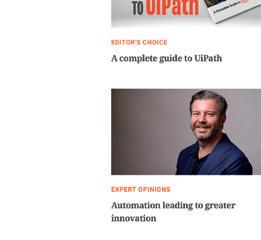





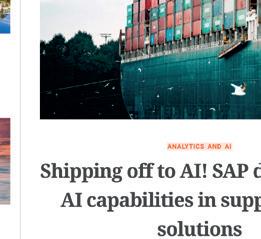


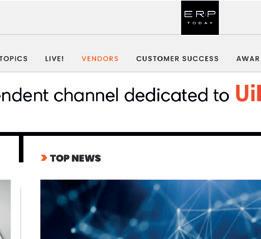
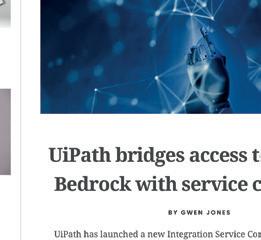

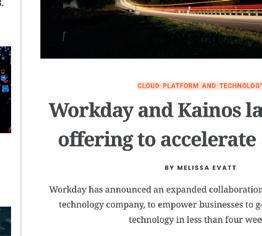
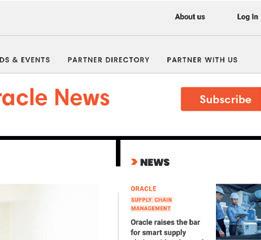

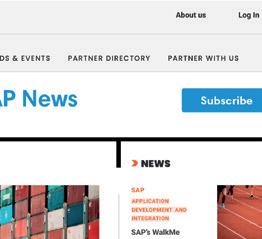


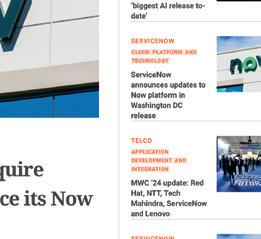
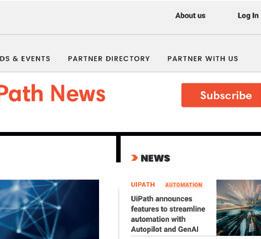

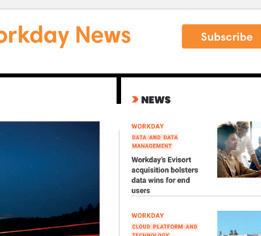






ORACLE AND IFS ON HOW AI AND LEADERSHIP WILL GO HAND IN HAND TO DETERMINE ORGANIZATIONS’ SUCCESS
BY YOANA CHOLTEEVA
What do AI and leadership have in common? Currently, a lot. Now the technology has entered virtually every sector of work (as some tech leaders predicted), no one could’ve depicted exactly how impactful AI would become in the span of just a few months. In the meantime, resilient leadership will continue to play an ever-so-important role as technology advances.
What marathon runners, leaders and AI know about overcoming hurdles
As human experiences often show, outside-of-work passions can significantly boost one’s drive and key skills in their daily job, inspiring them to innovate more, be more creative and strive to excel, Cathie Hall, IFS chief customer officer, has found.
Citing her experience of mentoring young people by volunteering as an explorer scout leader and trustee and competing in ultra-marathons, all experiences that enrich and inspire us could be quietly contributing to invaluable skills that most lines of work can benefit from. While admitting that ultra marathons are far from everyone’s cup of tea, challenges like these spark resilience and teach some universal skills, like overcoming the fear of failure, resilience, humility and teamwork.
“You learn to take on a big problem like ‘how am I going to run 100 miles?’ and break it down because nobody can run 100 miles, right? But actually, you can run a mile 100 times. So how do you break things down? How do you plan and stick to the plan and achieve those milestones and celebrate them as you go along?” Hall tells ERP Today.

Or equally, developing a strategy to predict your reaction to unexpected events like running out of water, spraining an ankle or getting lost. It’s about “what’s your mental strategy and your mental rehearsal, right? And all those things have a direct applicability to work,” she says. These fortified leadership skills can help with service delivery and working with customers, especially with big transformation projects where teams are unsure where to start. “They need that guidance. When things have gone a bit wrong, they’re feeling under pressure. So I think it’s also important being able to use those skills, having a slightly different perspective on it, helping coach customers on how to break it down, what to focus on, how to get across the hurdles, how to solve some of the individual challenges so that we can get to delivering value.”
Equally, with more enterprises finding themselves in the middle of the AI push, CEOs and CIOs among other company leaders are more often than ever approaching tech companies with the question “What’s our AI strategy going to be?”
However, it doesn’t mean those customers are falling behind the curve, as most are already using AI to optimize their production schedules. “And a lot of our manufacturers are already using IoT to do asset performance management so we’re able to blend those two things for a higher level of productivity, being able to predict to a much more accurate level where something might be trending or what action a human might need to take,” Hall explains.

ORACLE IS ADHERING TO THE IDEA OF AI EMBEDDED WITHIN APPLICATIONS AND THE FLOW OF WORK
Many companies are already using copilots and have established what they are able to do using AI in combination with different technologies, including rule-based automation, IoT, machine learning and generative AI anomaly detection and optimization.
By “combining all those services, companies see those second, third generation use cases coming through [...] and taking value to the next level,” Hall highlights while adding that one of the advantages of IFS’ services is that “this technology is embedded and customers are adopting it as they go anyway”.
In a similar fashion, Oracle is adhering to the idea of AI embedded within applications and the flow of work, which means that it’s not required for workers to interact with an additional service on the side.
“It’s just doing their job more effectively in the applications. For example, if you are a recruiter, you don’t have to write a job description from scratch. You can have the sys-











































tem suggest a text based on existing knowledge about that type of role, based on other positions that have been posted in the past, etc. And using the very human-sounding language of LLMs,” Miranda Nash, group VP of applications development and strategy at Oracle, tells us.
Separating the use of embedded enterprise AI solutions and copilots from the common experience of individuals using ChatGPT for personal help, she points out how unlike the OpenAI tool, in an enterprise setting, customers lean on all the existing data in their HR system or ERP system, which becomes context to the large language model to deliver a good result.
In this case, retrieval augmented generation (RAG), a technique for enhancing the accuracy and reliability of GenAI models with facts extracted from external sources, is a step that helps models clear up ambiguity in a user query. Here, it comes as just another level of context, offering more data, that becomes “the source of truth” to ensure that the AI answer is grounded in that reality.
“As the vendor, we only deliver prompt engineering. So we write the prompts in embedded AI, which is very powerful because prompt manipulation is the number one way to get models








CEOS AND CIOS ARE ASKING VENDORS
“WHAT’S OUR AI STRATEGY GOING TO BE?”














to hallucinate”, she says. “So we avoid that basically and evaluate and measure what’s happening behind the scenes. These are all the factors that make AI work in an enterprise at a scale that you don’t really think about when you’re using ChatGPT as an individual.”
In a classic AI example, the way that a nonPO invoice is matched to the right account code in cloud ERP is facilitated by training models based on historical data.
“And we test how likely statistically that answer is to be correct,” Nash explains. “We don’t even present the answer to the user unless it crosses the threshold of confidence, so in practice, customers are getting 98 percent accuracy, 90 percent coverage. That’s how we measure it and know if it works.”
So with modern technology enabling more streamlined business functions and better leadership in organizations by allowing leaders to gain more insight quickly, AI can be seen contributing to better leadership, readying companies for the future of work.
Who’s to say that AI isn’t here to stay and its limitless potential won’t become just as key as organizations’ robust and future-centric leadership?
To handle complicated processes in an ERP system, regression testing can help mitigate risks of defects or miscalculations.
Handling multiple-step production processes like order-to-cash in an ERP system can be a hefty task that may affect user experience and even disrupt business operations due to potential defects or miscalculations. This is why it is crucial to have processes such as regression testing in place that aim to help mitigate that risk.
Regression testing allows companies to check that everything still works as expected after changes, such as updates, have been applied to software. There are two types of regression testing: manual and automated. The automation process uses test scripts, workflows and other processes within a regression testing technique. Meanwhile, manually performing regression tests involves human oversight and adaptability but can be time-consuming and prone to error.
Knowing the difference between the two and selecting the type of testing
right for your business can be beneficial. This is shown through the case study of CertainTeed, a manufacturer of light and sustainable building products for both commercial and residential construction, who opted for Original Software’s automated regression testing platform in its search for a streamlined and efficient testing experience.
Marc Croquette, senior IT director at CertainTeed, joined the company around seven years ago while it was undergoing a major SAP transformation. At that point, the organization already had a team that was supporting its SAP journey, who were preparing for the upcoming change management and handling overall maintenance. These consultants were spread across different countries, including the US and India which, according to Croquette, allowed room for regression error on a manual front.
Undergoing a major transformation
BY EKATERINA DUDAKOVA
requires continuous changes in the system which is exactly what CertainTeed carried out – on a weekly and quarterly basis, the business was pushing for small and big changes to support the SAP transformation. Croquette explained that guaranteeing the business process stability was the first priority for the team. This was due to the fact that CertainTeed’s 4,000 business users needed to be able to log onto the system with no unexpected changes that could cause operational disruption.
When the company began performing tests on various business functions, such as the order-to-cash process and planned to install testing and insurance policies for 250 scenarios, expecting to spend a typical two to four hours on each, it soon realized that it instead took over a day to complete just a single one.
“So, multiply the complexity [of the order-to-cash process] by the number of scenarios and you get an idea of what we would have to do every time we were
pushing a change to the system to make sure nothing broke,” Croquette said.
The realization of the infeasibility of this process, alongside the need to cater to user convenience, led CertainTeed to seek a solution in automated regression testing.
When running an ERP system, don’t leave your bags behind Aiming to test the system en masse, the company required a solution that didn’t follow the conventional manual rules of regression testing. As Croquette explains, instead of having a manual process where you “replay a scenario, push that button, click here, do that, enter that value here and then play the process”, the team wanted to find a system that would provide them with a simple interface where resulting changes could be clearly displayed.
The system was described as similar to a “bag claiming process” by Croquette. “It’s almost like the bag claim that you have at the airport, where all the passengers are boarding off the flight and they go [...] to pick up their bags.”
“If at the end of the process there are some bags left on that belt, then we get an issue – something [will go wrong because] everybody was supposed to pick up their bag. Same thing here. The analysts are coming up and picking up [the] differences [that were made in the system].”
After doing its research and conducting a request for proposal (RFP), CertainTeed came upon Original Software, a provider of automatic software testing products and services. Croquette explained that Original Software “was the only vendor who had 85 percent of the [software that CertainTeed] was looking for” and for the remaining 15 percent, the company promised to help however it could. This is how a seven-year partnership - and counting - began between the two organizations.
CertainTeed took their collaboration as an opportunity to build an SAP competency center with a “dedicated team of four.” Establishing a team that oversees business information and data to provide expertise for project or program
support was important to Croquette and the team. This was as it would allow it to continue “enriching” its use of Original Software’s testing platform, building upon more tested scenarios each month. Croquette told ERP Today that this was especially crucial because of the ongoing mergers and acquisitions (M&A) transaction cycles that the organization was going through.
“That means that we’re onboarding new companies every three months to the SAP template,” Croquette added. “We started six years ago, with two [team members] in India, and we wanted to make sure that [would] be the competency center.
“[...] Since then, we grew it to four people and expanded the scope to more than just SAP, including a transportation management system. [...] But what’s really important is that it took us barely a couple of weeks from the time we concluded the RFP and signed the contracts to the time we had the [competency center], which we’ve kept enriching [since].”
Since the partnership launch and establishment of its competency center, CertainTeed and Original Software together achieved what Croquette calls a “sleep insurance policy” due to automation helping to prevent defects and errors when changes are pushed “between Thursday and Friday.” This allows Croquette (and his entire team) to sleep easy and not worry about any breakages coming his way by the end of the week.
instead, they can simply screen-record their process.
He added that the company is “enriching the insurance policy” by bringing in tools for regression, as tested on customer portals and the billing platform to ensure that the end-to-end process is untouched and CertainTeed can continue “delivering [its] commitment to business process stability.”
With Original Software’s automated no-code regression testing platform, users can keep up the testing framework with any business change. This way, they have breathing space away from thinking about a particular step in the daily production process.
Similarly, with a system that can automatically point out defects, it is possible to prevent an issue or error before it goes live, thus preventing any loss of efficiency, revenue and customers.

“IT’S ALMOST LIKE THE BAG CLAIM THAT YOU HAVE AT THE AIRPORT”
As an example, the company has prevented over 20 critical defects and tests around 300 ensured scenarios on a weekly basis for the mainstream processes for six different business units. An additional benefit is that users don’t have to manually build hard-coded regression testing scripts themselves –
Looking to the future, CertainTeed is planning to continue leveraging Original Software’s automated regression testing when it “replaces its entire HRIS and payroll systems,” transforming the former in entire North America and the latter across the US and Canada. As Croquette explained, these systems cannot afford any hiccups as they support over 18,000 employees, so the “tremendous change” is scheduled for January 2026, with the company extending its automated regression testing insurance coverage.
CertainTeed’s decision to choose automation over manual regression testing proved to live up to the organization’s needs and goals, opening doors for even more ambitious projects and digital transformations. So, next time you’re lying in bed worried about potential breakages, perhaps automated regression testing is one solution to help you sleep easily.
BY ROBERT HOLLAND

bvious fact: cloud ERP is central to every vendor’s lexicon. It’s seen as the future of enterprise tech. However, I don’t necessarily think this is where most customers want to be; it’s more about where vendors believe the market wants them to go. Investors, trends, and other market forces drive this shift. Organizations have been moving their enterprise workloads to the cloud for over a decade. The surprising thing is that many vendors thought this transition would be completed in five to ten years, but in many cases, we’re still barely getting started. Take SAP, for example. There were about 50,000 ERP customers around the time of the S/4HANA release. Of those, around 25,000 licenses for S/4HANA have been sold, but half of those are net new. That means only about 12-13,000 of those 50,000 customers have moved to S/4HANA, let alone cloud ERP. With Rise with SAP, adoption numbers are around 6,500. There might be more S/4HANA Cloud customers, but in terms of the Rise construct, only about 6,500 have adopted it. That leaves 35,000-38,000 onpremise ERP customers who haven’t moved those workloads to the cloud.
Vendors partner with hyperscalers as AI dev is so expensive
When looking at cloud adoption, it’s often the financial products and older ERP systems - manufacturing planning, data warehousing - that are slow to move off-premise. CRM, on the other hand, has seen faster cloud adoption, driven by Salesforce, which has become the de facto CRM platform for large organizations.
This brings up the need for integration between cloud and on-premise systems, especially when using non-SAP or non-Oracle solutions. Old financial solutions, ERP systems, and similar workloads are slower to move off-premise. Despite cloud being central from an infrastructure standpoint, there’s still a long way to go.
A significant challenge for ERP vendors like SAP and Oracle is the lock-in approach they use compared to the more flexible “what would you like to do?” approach of the hyperscalers. This makes hyperscalers more appealing to organizations, particularly those with enterprise agreements that provide cloud credits. Organizations don’t want to lose those credits, so they have an incentive to use them, even if their ERP vendor would prefer them to stay on their platform. One hyperscaler, AWS, has been very competitive, particularly in the manufacturing sector due to its IoT capabilities. Companies like Oracle and SAP, which also have their own hosting solutions, find themselves in a complex competitive landscape. For example, with Rise with SAP, the deployment is in SAP’s environment on whichever cloud provider you choose, whether it’s Google, Microsoft, or AWS, but it’s still within the SAP contract. Interestingly, very few organizations use just one cloud provider; almost all use two or three, and the larger the organization, the more they have. Lastly, it’d be remiss to not talk about AI, around which the cloud conversation has definitely been evolving. AI has introduced new considerations, particularly around automation, data analysis, and operational efficiency. But in my research, it hasn’t moved the needle on ERP adoption yet, as people are waiting to see what happens. They’re also waiting for use cases - and to see what it’s going to cost them. This is why so many vendors are partnering with hyperscalers as it’s still very expensive to develop AI. As always, even if everyone is talking in as high pitched a volume about cloud and AI as they possibly can, money always talks louder.
Robert Holland, Cloud Leader, Wellesley Information Services

310 million passengers a year fly safely thanks to aircraft maintained by


















